







With more than two decades of experience as a media professional, Christine has worked in newsrooms across Canada, Vietnam and Australia. She joined the Prime Creative Media team 12 years ago, and today oversees more than 43 titles, including a dozen print and digital transportation titles. She continues to lead a team that focuses on continuous improvement to deliver quality insights that helps the commercial road transport industry grow.
Over the past two decades William has published widely on transport, logistics, politics, agriculture, cinema, music and sports
He has held senior positions in marketing and publicity for multinational businesses in the entertainment industry and is the author of two plays and a book on Australian film history. Like many based in Melbourne he is in a prolonged transition of either returning or leaving.
A seasoned transport industry professional, Peter has spent more than a decade in the media industry. Starting out as a heavy vehicle mechanic, he managed a fuel tanker fleet and held a range of senior marketing and management positions in the oil and chemicals industry before becoming a nationally acclaimed transport journalist.

Louise joins Prime Mover after nearly 25 years as a writer. Starting her career as a reporter at the Toronto Star, she has spent much of the last 15 years as a design writer and editor. In 2020, she was shortlisted on the Richell Emerging Writers Prize list. Originally from Nova Scotia, she lives in Melbourne with her two children.
Peter has completed a Bachelor of Media and Communication (Media Industries) degree at La Trobe University, and he brings a fresh perspective to Prime Mover. He gained valuable experience at Upstart, La Trobe’s newsroom, work that has been supplemented by direct industry experience in a Council placement.
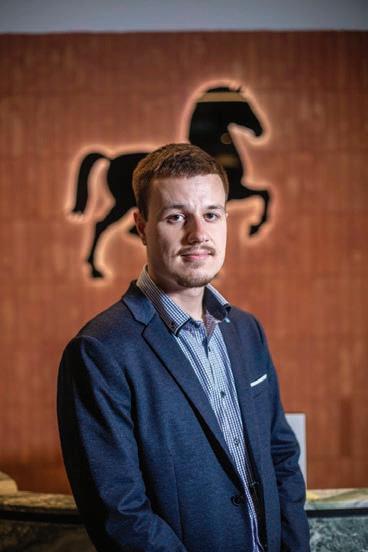


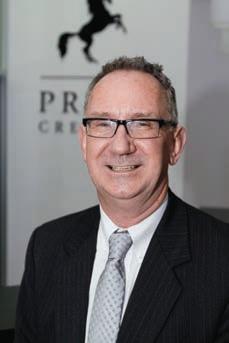
Peter has a strong interest in commercial road transport, and in contributing to Prime Mover’s efforts in growing the industry.

Australia’s leading truck magazine, Prime Mover, continues to invest more in its products and showcases a deep pool of editorial talent with a unique mix of experience and knowledge. www.primemovermag.com.au

Handling placements for Prime Mover magazine, Ashley has a unique perspective on the world of truck building both domestically and internationally. Focused on delivering the best results for advertisers, Ashley works closely with the editorial team to ensure the best integration of brand messaging across both print and digital platforms.
ceo John Murphy john.murphy@primecreative.com.au editor William Craske william.craske@primecreative.com.au managing editor, Luke Applebee transport group luke.applebee@primecreative.com.au senior feature Peter Shields writer peter.shields@primecreative.com.au
business Ashley Blachford development ashley.blachford@primecreative.com.au manager 0425 699 819
art director
Blake Storey blake.storey@primecreative.com.au
design Kerry Pert , Louis Romero, Tom Anderson
journalists
Peter White peter.white@primecreative.com.au
Louise Surette louise.surette@primecreative.com.au
design production
Michelle Weston manager michelle.weston@primecreative.com.au
client success Salma Kennedy manager salma.kennedy@primecreative.com.au
head office 379 Docklands Drive, Docklands VIC 3008 enquiries@primecreative.com.au
subscriptions 03 9690 8766 subscriptions@primecreative.com.au
Prime Mover magazine is available by subscription from the publisher. The right of refusal is reserved by the publisher. Annual rates: AUS $110.00 (inc GST). For overseas subscriptions, airmail postage should be added to the subscription rate.
articles
All articles submitted for publication become the property of the publisher. The Editor reserves the right to adjust any article to conform with the magazine format.
copyright
PRIME MOVER magazine is owned and published by Prime Creative Media. All material in PRIME MOVER magazine is copyright and no part may be reproduced or copied in any form or by any means (graphic, electronic or mechanical including information and retrieval systems) without written permission of the publisher. The Editor welcomes contributions but reserves the right to accept or reject any material.
While every effort has been made to ensure the accuracy of information
Prime Creative Media will not accept responsibility for errors or omissions or for any consequences arising from reliance on information published. The opinions expressed in PRIME MOVER magazine are not necessarily the opinions of, or endorsed by the publisher unless otherwise stated.
MAN’s powerhouse, the TGX with 26 t GVM powered by MAN’s mighty 15 L 640 hp D38 engine, comes with a range of cabs including the maximum GX cab – the king of the jungle!
Excellent in line haul, roadtrain and heavy haulage applications, the TGX 26.640 GX is MAN’s premium offering. With a class-leading 840 hp engine braking capability, no load or terrain is too challenging.
Visit man.com.au to learn more about our new MAN truck generation and how it delivers excellent driver fit, great efficiency and economy features, and optimised uptime, and makes for a strong business partner.




“You need to stay in front of the game. Everyone can cart fuel. It’s how you do it differently that makes you the place that people want to work and the place of choice for customers.”



28 Chain of Command
Carrying the largest jet fuel spec’d fleet in the country, Hills Tankers possesses over 100 prime movers that it deploys along the northern eastern seaboard servicing airports, mines, retail outlets and military bases.
34 Chemical Brothers
As a niche segment, chemical transportation by road often involves a different mindset to fuel haulage. Unanderra Tanker Hire is one of the industry’s leading practitioners.

In the latest step in its national fleet renewal program, Lineage Logistics took delivery of ten brand-new Kenworth K200s which are now transforming its linehaul operations.
42 Coming Attractions
While it may come as a surprise to some, the Phillip Island Penguin Parade and Isuzu both have one thing in common.
Hino has set a course embracing the latest in commercial vehicle technologies, while also committing to its hybridelectric developments.

TEST DRIVE
62 Diesel Lives!
Scania’s all-new 13-litre diesel engine is an important step in the decarbonisation of road transport.

White paint markings found outside of Faya-Largeau, the largest city in northern Chad, serve as reminders even today of the hundreds of mines left behind from the war with Libya. The conflict itself lasted for nearly a decade and by the mid-1980s escalated to the point that Gaddafi’s Libyan forces occupied most of the country’s north. Despite having numeric advantages mostly in foot soldiers, Chadian forces were hopelessly outgunned, as it possessed little military equipment capable of going up against Libya’s Soviet T-55 tank. That is until France and the United States intervened. In an unconventional move, the French Air Force supplied Chad’s military with some 400 Toyota HiLux pickup trucks. This dramatically turned the war in Chad’s favour.
The HiLux proved a versatile, makeshift armoured vehicle in the harsh environment often with a .50 calibre assault weapon or MILAN anti-tank guided missile system rigged to the truck bed. Fuel consumption, manoeuvrability and ease of conversion, what’s more, made it formidable for desert skirmishes.
Even so, the dangerous terrain laden with ‘sleeping policemen’ still posed a major challenge for Chadian forces until it was discovered that the HiLux could be jounced over Libyan anti-vehicle mines without setting them off. To do so safely, irrespective of payload, they needed to exceed speeds of 62 mp/h. How this exact speed was arrived at is a matter of contention. Whether it was discovered via kamikaze R&D or brilliantly intuited by the young commander, 31-year-old Hassan Djamous, who was responsible for major victories at Audi Doum and Fada, or rather the result of simply converting the speed to the metric system, an equivalent of 100 km/h, which was in practice at the time in both North Africa and France, speculation mostly eclipses material facts. Djamous personally led troops in trucks over Libyan-laid minefields at Ouadi Doum as proof of concept. Initially, driving at a speed of 90 km/h was thought to cause a three-second delay before the mines exploded. Djamous was not soon after badly injured demonstrating his three-second technique leading, not surprisingly, to an increase in the required speed. He later returned to the fray at Maaten al-Sarra. The wheels of the vehicles when travelling at 100 km/h, as another theory would have it, were in contact with the mines for an estimated 1.8 milliseconds. Legacy armoured vehicles typically can’t travel at this speed leaving more time for the mine, which relied on a magnetic field, to be triggered. As a diesel engine, especially one made before 1984 when many of the Toyotas were produced, is averse to being revved for extended periods in top gear, a long-range speed is likely to have been maintained before any of the pickups entered a minefield.
What kind of timing was involved? How much downward force would it take to set the mines off? More questions abound. How low was tyre PSI to reduce contact pressure? If downward force does not change with momentum, how would velocity alleviate the pressure? Could the huge rear leaf springs of the HiLux, presuming the theory is accurate, have helped it to stay level with extra weight? On 2 January, 1987, Djamous deployed 3,000 men into battle at Fada where Libya lost almost 800 soldiers, 92 tanks, and 33 infantry fighting vehicles. Chad’s losses were minimal, just 18 soldiers and three pickups. The “pale ectoplasm of statistics” as Robert Penn Warren likened the cold application of data in the American Civil War, of course, doesn’t account for the 7,500 dead nor the $1.5 billion dollars’ worth of military equipment destroyed or captured during hostilities that finally ended when Libyan forces were expelled in 1987. The HiLux has since become an indispensable vehicle for military groups across the Middle East and Northern Africa. Indeed, it was so effective in the Chad-Libya conflict historians often refer to it as the Toyota War. In nearby Liberia, where unrest at the time was already mounting, civil war would soon break out. The Toyota HiLux again would have a major role to play. Although with cannibalism, witchcraft and rebels often affixing human skulls to the grilles of their vehicles during the conflict, historians have naturally been less than earnest in associating any major manufacturer with it.


Change is inevitable, by embracing it with the Hino 300 Series Hybrid Electric, you can gain a genuine competitive advantage. Make real savings from your fuel and maintenance costs, reduce your operating costs and more. With superior technology at work, the Hino Hybrid Electric will deliver up to 20%* reduction in both fuel use and emissions, compared to a traditional diesel truck. As there is no starter motor, the regenerative braking system charges the batteries which means increased on-road time with no recharge requirements, and a 16% annual maintenance cost reduction due to less wear and tear on the brakes. That’s the power of change, that’s the Hino Hybrid Electric. Visit hino.com.au

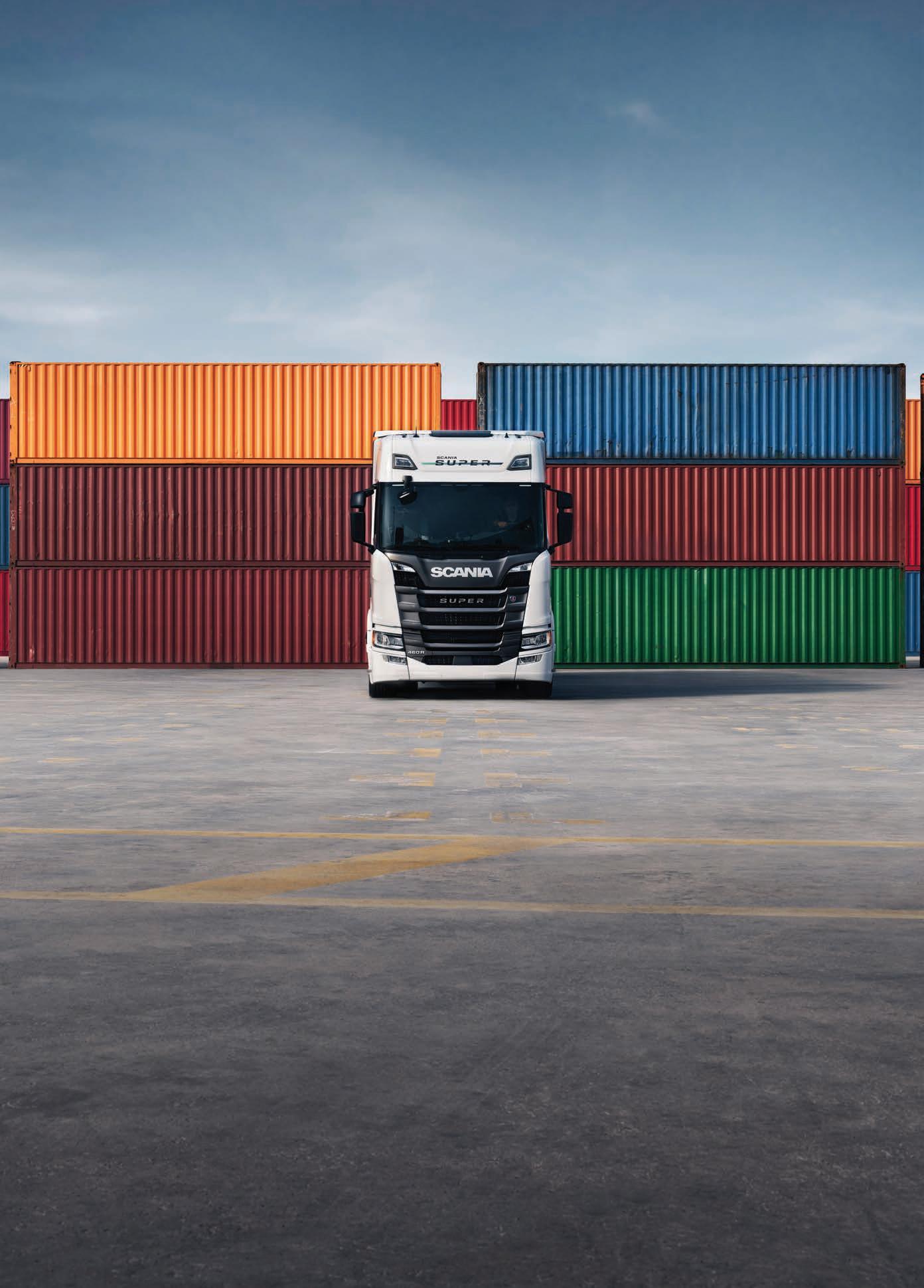
A double stacked container vehicle has been trialled for the first time on port and public roads in Australia.

The Super B-double Double Stacked vehicle was operated by Qube as part of a trial conducted under stringent safety and operational conditions at the Port of Brisbane.
Both the National Heavy Vehicle Regulator (NHVR) and the Australian Road Research Board (ARRB) oversaw the trial which involved the vehicle carrying eight empty twenty-foot equivalent (TEU) containers on a defined route within Qube’s port facilities and limited public port roads. The trial was conducted under a temporary permit from the NHVR and temporary consent granted by PBPL as the Port’s road manager. The Super B was pulled by a Scania
prime mover.
Nicknamed ‘the London Project’ in homage to London’s iconic double decker buses, the high productivity vehicles have the potential to increase operational efficiencies, given their ability to move 12 TEUs at a time. Qube also expects the double stacked triple trailing units produced by O’Phee Trailers and the Drake Group, will lower emissions by eliminating truck movements.
PBPL CEO, Neil Stephens, congratulated all who were involved on the successful trial which followed a significant period of design, engineering and consultation by Qube with its stakeholders, including PBPL. “This is a fantastic outcome for Qube and all parties involved today. It’s also a clear demonstration of
the collaboration and innovation being achieved by our customers and partners here at the Port that’s enhancing productivity and efficiency in their operations,” said Stephens. “As Port Manager, one of our key priorities is investing in infrastructure to support supply chain efficiency,” he said.
“We were pleased to deliver road improvement works and upgrade the access/egress to a number of facilities to support this new vehicle and Qube’s innovation.”
Under its current permit and consent conditions, the new double stacked vehicle will transport empty containers on a defined route within Qube’s facility and limited public port roads, under stringent safety and operational conditions.


Updated laws introduced by the Western Australian Government to safeguard the rights of ownerdrivers of heavy vehicles operating in the road freight transport industry have recently come into effect. The amended Owner-Drivers (Contracts and Disputes) Amendment Act 2022 passed Parliament in October last year and is the result of extensive consultation with the Road Freight Transport Industry Council and the Road Freight Industry Tribunal.
The amendments will help improve business dealings between ownerdrivers of heavy vehicles who transport freight and the people who hire them, by clarifying the regulatory responsibilities of both parties.
The changes include the introduction of minimum notice periods of 90 days
for termination of a contract longer than three months, and seven days for contracts less than three months.
The role of the Road Freight Transport Industry Tribunal has also been clarified to make sure it can deliver fair and efficient outcomes in dispute resolution between owner-drivers and hirers. Non-compliance with owner-driver guideline pay rates will now be factored into dispute resolution decisions made by the Tribunal. This change places more responsibility on hirers to offer fair pay for owner-driver services. In addition, workplace right of entry provisions have also been updated to allow an authorised owner-driver’s representative to enter a workplace to investigate suspected breaches of the Act.
WA Transport Minister Rita Saffioti said
Brisbane based refrigerated transport rental company, Eurocold, has announced significant expansion plans for key stakeholders. A pipeline of initiatives will be bolstered by an $100 million investment according to Managing Director, Avraam Solomon which will see expansion through new markets, including New Zealand and further development set for sister company Revora.
After it launched a Western Sydney facility earlier in May, Solomon’s vision is expansive, committing to a $100 million spend within the refrigerated transport industry with the focal point being expansion into Melbourne, Perth and ultimately New Zealand. This commitment over the next three years will see up to 800 trucks being deployed, the initial goal being 500 trucks. The nexus of Eurocold’s establishment three years ago was securing the Australian rights for Isokit refrigerated bodies. In that time, Eurocold has become one of the leading companies in the space combining decades of experience, innovation and a customer
service focused approach.
Solomon and his key executives have spent significant time researching global trends in refrigerated trucking – both in person and anecdotally – and, when it comes to renting or leasing trucks, the Australian market lags in uptake when compared to global counterparts –something Eurocold wishes to change.
“I’ve spent a lot of time in Europe in the last 12 months looking at large businesses that specialise in refrigerated truck leasing and rentals,” he said.
“For example in Europe, of all the vehicles that are produced every year, we know that 58 per cent of the builds go into long-term rentals trading to leasing off balance sheet.
“Currently in Australia, it is a fraction of that – the percentage of rental take-up is more like 1 to 3 per cent – so there is significant opportunity for transport fleet operators to scale with flexibility and ensure their fleets feature the latest technology, which then flows onto a second hand market,” said Solomon.
“We see ourselves as a large participant in the industry to get rigid vehicles that
the updated laws protect the rights of small businesses and independent operators who own and drive trucks in the freight industry.
“These are the small operators who are making a big difference to our economy and our lives, by helping to keep our supply chains going and delivering goods across our State,” Saffioti said in a statement.
“Our new laws will provide them with better protection and improve their position in matters including job security and fair pay, as well as clear processes to follow to resolve disputes.
“We have consulted extensively with industry to update these laws which will result in more streamlined and reasonable business dealings between owner-drivers and people hiring their services.”
are of the highest quality and standard onto the road, so we’re always using the most modern chassis’ and sourcing the best Isothermal bodies from around the world.”
Revora, which was launched in March, will be a fully owned sub-brand that specialises in the rental of rigid, electrified trucks.
General Manager, Nathan Gore-Brown announced that Carrier will be a supplier of new technologies for the electric, refrigerated transport industry in Australia.
“Revora is a real investment to us. It is something that is costing us money every month, which we forecast will take 12 months or two years before starting to see significant returns,” said GoreBrown. “Revora and Eurocold for that matter are companies that really want to see the industry make a difference in the long-term sustainability of refrigerated transport – and to our environment –because we believe in it.”
Gore-Brown said the usage situation for clients is what will drive the selection of chassis and body size.
Heavy Vehicles that disrupt traffic and shutdown tunnels could be sidelined for up to six months under new laws proposed in New South Wales. The NSW Government has been prompted to take action after repeat incidents saw tunnel closures in one week caused by incidents involving overheight trucks. Under a new proposal, the State Government is advocating heavy vehicles that cause Sydney tunnel closures are to be stripped of registration.
Overheight trucks were repeatedly compromising the safety of motorists and testing the patience of the entire city according to Minister for Roads John Graham.
“A small minority of drivers are holding the city to ransom,” he said. “They are neither professional nor responsible, and they are continuing to ignore the message about overhead height restrictions. They are threatening the safety and the patience of motorists.” In response, the NSW Government this week approached the National Heavy Vehicle Regulator (NHVR) to work closely with Transport for NSW to initiate more investigations and bring charges against trucking companies and owners under “aggravated circumstances” provisions. Graham said prosecutions of companies under the rules, including heavy vehicle chain of responsibility provisions, had so far been limited and the NSW Government was keen to see more action and referrals from the NHVR that allows NSW Transport to take an offending truck off the road for up to six months.
Since August 2022, when heavy vehicle regulatory functions were transferred to the NHVR, just four registration sanctions have been completed against trucking companies by Transport for NSW on referral from the NHVR for overheight breaches in relation to tunnels in NSW and of these one was thrown out by the court.
To enhance warning systems for
the Sydney Harbour Tunnel, the NSW Government has approved the immediate deployment of $5 million in infrastructure upgrades, sensors, signage and enhanced slip ways for trucks that approach tunnels with overheight loads.

For the Sydney Harbour Tunnel, this will involve moving warning signs and sensors further back along the Warringah Freeway to ensure heavy vehicle drivers can take earlier evasive action to avoid blocking traffic at the tunnel portal or worse. This work will start in July and is intended to be fully completed by December.
Police will continue to focus on roadside compliance on overheight trucks, targeting key corridors such as the Sydney Harbour Tunnel. A social media education campaign in collaboration with the NHVR was recently launched. The NSW Government has ruled out closing the Harbour Tunnel to trucks altogether because the majority of heavy vehicles are already prevented from crossing the Sydney Harbour Bridge due to mass constraints.
Closing the tunnel to heavy vehicles would precipitate truck drivers using alternative routes across Sydney that in some cases would add 42 kilometres to the current route between Port Botany and the M1 at Wahroonga and involve many more truck movements through
Sydney suburbs.
Recently a number of penalties for over-height vehicles were increased, with some being doubled. These include on-the-spot fines for over height trucks entering Sydney tunnels of up to $4,097; demerit points for the offence are 12; suspension period for a driver’s licence up to six months; and registration suspension period for trucks up to six months.
According to Graham, good drivers know the height of their truck and stick to the tunnel height limit.
“My message to that handful of bad drivers and their truck companies is you will be hit with the harshest penalties possible, more often,” he said. “We have agreed to work with the National Heavy Vehicle Regulator to increase awareness amongst truck drivers, but also to crack down on trucking companies who breach these rules. We will be taking their trucks off the roads,” Graham continued.
“One thing I do not want to do, is to close the Harbour tunnel for the vast majority of good truck drivers. That would simply send trucks into our suburbs, creating city-wide chaos and congestion.”
Road Freight NSW last month cautioned the NSW Government from banning high productivity vehicles from Sydney tunnels.
Volvo Trucks has confirmed Followmont Transport has made the first Australian order of the recently unveiled heavyduty FH Electric. The FH Electric is the largest e-powered truck in Volvo’s fleet of electric vehicles.
With a range of 300km, it is considered a well suited platform for extended transportation routes and intercity travel. The deal also includes the mid-sized FL Electric, which has a range of 400km and is designed for urban delivery and intercity transportation. Both trucks are anticipated to be delivered to Followmont Transport in late 2023.
Martin Merrick, President of Volvo Group Australia said it was a huge milestone for Volvo Group.
“The FH Electric is set to be a game changer for transportation in Australia. It will play an important role in the decarbonisation of Australia’s transportation sector,” he said. “This investment allows Followmont to set itself apart as a company that is stepping up and helping realise a future with cleaner and greener vehicles on Australian roads.”
Investing in the two e-powered trucks was a landmark occasion for Followmont, according to CEO Mark Tobin, as it looked to help its partners decarbonise.
“At Followmont, we take our responsibility seriously and understand this is the time for change,” he said.

“We’re excited to take delivery of our first electric units later this year, getting on the front foot to further reduce our impact on the environment and taking our strategy to the next level. “Through investing in vehicles, technology, infrastructure, and our communities, we will continue to play our part in supporting present and future generations.”
As Volvo celebrates the inaugural order, it continues to call for urgent regulatory change to the current rules that limit steer-axle-to-mass ratios to 6.5 tonnes in Australia. This stops heavy-duty vehicles including the FH Electric from driving on Australian roads.



increase the fitment of safety technologies to new heavy vehicles by aligning local width regulations with those in major markets such as Europe,” said Hourigan. “These reforms will give industry access to a greater range of heavy vehicles fitted with the latest
“We want to hear from industry and further unpack how to implement these Australian Design Rule (ADR) changes into the Heavy Vehicle National Law
details of these reforms, the NHVR is proactively considering how these changes might change the HVNL.
“The heavy vehicle industry and truck manufacturers are ready for this next generation of safer trucks. The NHVR wants to make sure the HVNL is prepared to get these safer trucks on our roads,” Hourigan said.
The release of the paper means that the NHVR is seeking public comment on regulatory changes that have not yet been signed off by Ministers.
on how to implement the Australian Government’s Safer Freight Vehicle (SFV) reform proposals. It includes increasing the width of heavy vehicles fitted with modern safety technologies.

NHVR Chief Regulatory Policy and Standards Officer David Hourigan said the reforms would support the uptake of safer heavy vehicles by increasing the overall width up to 2.55m or 2.60m.
“The proposed SFV reforms would







According to the proposed SFV reforms, any vehicles exceeding 2.50m in width would need to be fitted with a mandatory technology package. This technology package includes features such as: Advanced Emergency Braking (AEB), Improved rear vision mirrors and systems; lane departure warning; side underrun protection (SUP); and improved conspicuity markings. Once finalised in Europe, blind spot information systems and advanced systems that detect pedestrians and cyclists on the passenger side of heavy vehicles will also be required as part of the mandatory technology package. Hourigan said while the Australian Government is still finalising the finer
HVIA Chief Technical Officer Adam Ritzinger acknowledged there was enormous interest regarding the reforms but expressed concern that the move would likely cause confusion within the industry.
“Up until now, the big question has been when an announcement will be made by Ministers,” said Ritzinger.
“In that sense, the release of the NHVR’s implementation plan has confusingly put the cart before the horse.
“Yet despite that, a greater concern is that the NHVR has considered implementation of wider trailers, which needs further detailed impact assessment before any decision can be made.”


























































































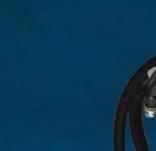
















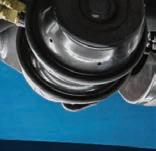





Woolworths Group has kick-started the transition by welcoming the first of 27 new EVs, which will begin delivering groceries to Woolworths’ Sydney customers over the next two months.
The supermarket giant’s home delivery fleet is currently made up of 1,200 trucks. It is anticipated that the very last combustion engine vehicle will join the home delivery fleet by 2027, as they are gradually decommissioned and replaced with EVs.
“Our home delivery trucks are a familiar sight in neighbourhoods across Australia, and within the next seven years, we want to make every one of them electric, and free of fossil fuels,” said Brad Banducci, Woolworths Group CEO.
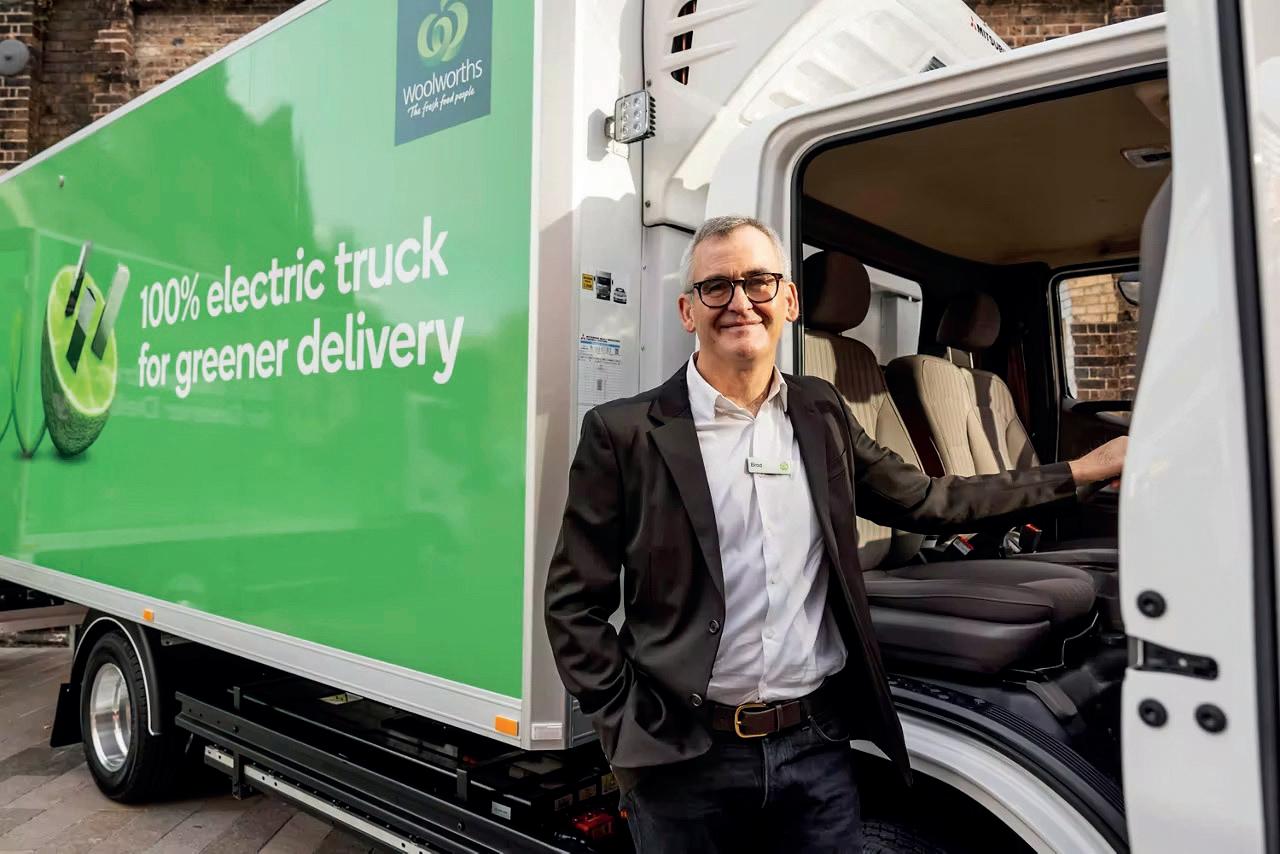
“The case for a low carbon future has never been clearer and we’re backing a better tomorrow for our communities and the planet by starting the transition now,” he said. “We’re proud to be putting 27 new EVs on the road in the coming weeks – in one of the many ways we’re working
All 27 of the new home delivery EVs will be based in Sydney, delivering groceries to customers across the CBD, Inner West, Sutherland Shire, St George region and Eastern Suburbs.
At present, public EV infrastructure to support commercial fleets remains limited. The trucks will operate out of Woolworths’ Customer Fulfilment Centres (CFC) in Mascot and Caringbah, which are dedicated to picking and packing the supermarket’s online orders. The CFCs have installed new EV charging infrastructure in preparation. Woolworths Group’s new EVs, according to a company statement, consist of two models manufactured by Foton Motor and SAIC Motor, which both offer sufficient working range to complete daily metro home deliveries before returning to base to charge overnight. They are fitted with a new, state-of-the-art electric refrigeration system that runs off the vehicle’s battery, ensuring groceries stay cold.
rigid vehicles, as it trials emerging technology to help decarbonise its fleet in the long-term.

Currently, the technology and infrastructure to support the load intensity and distances of long haul freight is still in its infancy. Woolworths Group also hopes to contribute to public infrastructure. It plans to ensure the right charging technology and locations are considered to meet the needs of electric metro fleets, as well as low emissions long haul freighter trucks which will require accessible recharging points across regional Australia.
By 2030 Woolworths Group intends to have reduced its overall operational transport emissions by around 60 per cent compared to today, and to have decomissioned more than 3,000 internal combustion engine vehicles from its company-wide fleet. Woolworths Group supply chain arm – Primary Connect –first launched an electric truck trial in Melbourne September, 2021 with Linfox.


With undisputable road presence and trusted reliability, there’s no place you’d rather be than behind the wheel of a Kenworth.


Cement Australia has been awarded grant funding to lease 24 batteries and convert six diesel prime movers in its Melbourne fleet to electric drivetrain. Backed by the Zero Emissions Vehicles Commercial Sector Innovation Fund (CSIF), Cement Australia will also install swap-out charging infrastructure with a minimum of three charging units. It will then complete a trial/demonstration stage for 12 months, which will include the testing and observation of
performance of Battery Electric Vehicle (BEV) prime movers in 24 hour operation; maintenance and repair requirements of BEVs; training of personnel; and reliability and wear and tear of charging infrastructure.
Upon completion, Cement Australia will also undertake a post-trial assessment of outcomes.

In December last year, Cement Australia delivered its first load in New South Wales with a BEV-converted Kenworth
Isuzu Australia Limited (IAL) has announced changes to dealer partners in Northern New South Wales, Far North Queensland and the Sunshine Coast. Northern New South Wales and regional Queensland, where the brand is opening a new Isuzu Trucks dealership, are recognised as key markets. The changes are expected to bolster the brand’s operations throughout the state, by further strengthening customer access to industry-leading road transport sales and aftersales support.
In Moree and Goondawindi Harvey Black Group has purchased Kenway & Clark. The new Dealership – Black Truck & Ag will commence on 9 June 2023.
In Cairns, shares of FR Ireland have been transferred to Eacab (effective 1 June 2023) — Eacab being an Eagers Automotive Group (EAG) subsidiary.
On the Sunshine Coast, ownership of Sunshine Coast Isuzu is being transferred from Perth-based CJD Group to the Toowoomba-based Prime Truck Group.
The newly established Prime Truck Group, with common shareholdings from the well-known Western Truck Group, now stretches from the Sunshine Coast to the Wide Bay and Burnett regions. Their expansion continues throughout the Bundaberg, Hervey Bay and Maryborough regions, with a new Isuzu Trucks dealership planned for the Fraser Coast – under the Prime Truck Group banner.
CJD Group will continue to operate Isuzu dealerships in Darwin and Alice Springs. IAL Head of Network Development, Ella Letiagina, acknowledged the changes and noted the Isuzu brand would be in
T410 Glider. The same vehicle was showcased at this year’s Brisbane Truck Show.
CSIF is a $5 million program that seeks to accelerate the uptake of ZEV technology in commercial settings, including the commercial passenger vehicle, freight and infrastructure industries.
Australia Post, UPS, IVECO Trucks, LumiRide, Mulgrave Automotive Innovation Centre and 13 Cabs have also received grants from the fund.
experienced hands moving forward. “Isuzu is looking forward to working with Dealer Principal Michael Watt and the team from Black Truck & Ag in Goondiwindi,” she said. “Up in Cairns, the Ireland family has a long and storied automotive history dating back nearly 100 years—in fact this business commenced on 4 June, 1923. We would like to thank Ireland Isuzu for their hard work and loyalty to the brand.”
With the change of ownership, Letiagina said there was confidence that Isuzu would continue to be strongly represented in Far North Queensland by Dealer Principal Jon Maurice and his experienced team.
“On the Sunshine Coast, CJD have been a great partner over the past five years,” continued Letiagina. “The team’s consistency has allowed the Isuzu business to grow and build outstanding customer relationships.
“I’m sure this next phase, under the Prime Truck Group led by Dealer Principal David Ohlberg, will see the operation go from strength-to-strength.
“In Queensland the Prime Truck Group is also enjoying strong growth and I’m pleased to confirm that Isuzu Trucks will be expanding with an all-new dealership opening shortly on the Fraser Coast.
“Given their experience with the Isuzu brand already, IAL is confident the collaboration will continue to yield excellent outcomes for all parties involved.”


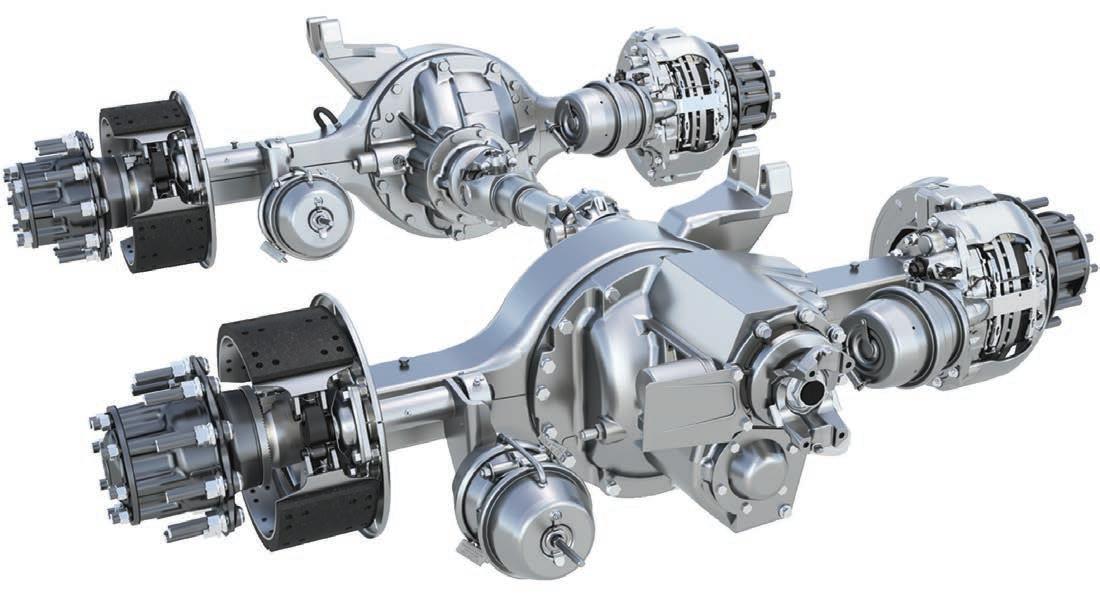
Australia’s most popular heavy-duty axle
Available in Linehaul (Pumpless) or Vocational (Pumped) configurations
Built tough to suit Australian conditions
The Victorian Government has opened a $1.5 million innovation centre for smart technology in fleet vehicles such as freight and emergency services trucks. The Connected Mobility Innovation Centre, developed by Directed Technologies, will enable it to develop smart sensors that can keep track of driver fatigue, tyre pressure and temperature of refrigerated cargo. The new centre’s system also considers a vehicle’s dimensions, weight and clearance when planning routes to help drivers travel safely and
efficiently to their destination. According to the State Government, this will therefore allow clients such as Australia Post to know exactly what is happening to their vehicles on the ground — improving safety and service reliability.
“We’ve built a world-class facility right here in Victoria thanks to the assistance of the Victorian Government and developed innovative solutions for the world’s biggest transport companies,” said Directed Technologies Executive
Director, Brent Stafford. Minister for Small Business, Natalie Suleyman, opened the Connected Mobility Innovation Centre yesterday. “We support businesses like Directed Technologies because they bring skilled jobs and investment to Victoria, which further cements our status as the nation’s advanced manufacturing hub,” she said. “Our advanced manufacturing industry supports many small businesses along their supply chain – boosting the economy and creating local jobs.”
She’s loved trucks from the moment she was introduced to them, and that passion has paid off. Coralie Chapman has been awarded the Excellence in Transport Award at the 2023 Women in Industry Awards night.
“The only thing that is not delivered on a truck is a baby,” is a line Coralie Chapman loves using, especially on those not familiar with the industry.
“When you use that line, people really start to think about it, and how much we depend on trucks,” she said. Chapman should know, she’s worked in almost every aspect of the industry over the last two decades. From having her own trucks and holding a heavy rigid license, to becoming a logistics expert and a passionate safety advocate. She was honoured at this year’s Women in Industry Awards in Melbourne, taking the Excellence in Transport award. “I love working in transport and have loved it since day one,” she said, accepting her award. “I’m quite lucky these days. I work for Humes Concrete, so I also do construction manufacturing, but I also get to play with my trucks every day.”
Chapman is well known within transport for working tirelessly to ensure the safety and viability of the industry, as well as encouraging women to choose transport as a career path and advocating for diversity and inclusion.
She took the opportunity during her acceptance speech to highlight the importance of making women feel invited into the world of industry, rather than intimidated.
“If there is a takeaway tonight, my hope is that instead of saying ‘male dominated industry,’ which can sound very threatening, especially for young women, we change it to ‘predominantly male’,” she said. “’Predominantly male’ sounds more inviting. If we can learn to change our language when we’re talking to women, it’s a big step towards getting more women into any predominantly male industry.”
Chapman got her foot in the transportation door almost 25 years ago, accepting a traineeship at Linfox, after hearing a talk by a Linfox employee.
“When he was on stage, he was so passionate and I knew I wanted that, come hell or high water,” Chapman said. She beat out two male applicants to get the position and although she admits she was “as green as they come,” has worked her way through the ranks, with posts in administration and operations, to become a scheduler.
Today she is the National Logistics Manager for Humes Concrete Products. In 2016 Chapman joined the Transport Women Australia board, serving as Secretary and now as Vice Chair. By 2018, she was one of 11 industry representatives handpicked for the Daimler Truck and Bus Future Leaders professional program where she developed a project to enhance the image of the industry and raise safety awareness.
Her previous awards have included the Cummins South Pacific Trucking Australia competition, and she was named the National Trucking Industry Woman of the Year at the 2019 Trucking Australia Awards Gala after being a finalist for two years running.
“I think the future of the industry is in good hands,” Chapman said, following her win. “We need people who are passionate whether they are male or female. There is so much more to this industry than meets the eye and so much more to do.”

The Connected Truck is transforming the way our teams work by bringing real-time visibility and information to the workplace. This technology enhances not only our driver’s safety with fatigue and maintenance tools, but also promotes sustainability through fuel efficiency and effective job management.
1300 111 477 TeletracNavman

A second CMV Truck & Bus site has become a fully certified Volvo Trucks Electric Vehicle Dealer. The Clayton dealership joins the Derrimut dealership which was certified in December last year.
As part of its certification, the CMV Clayton workshop, parts and sales teams undertook extensive training and completed all elements of Volvo Group’s rigorous EV certification process. The Clayton facility offers state-ofthe-art equipment and diagnostic tools, comprehensively equipped work bays, underground pits and before long brake and suspension testers. Further investments in these facilities and equipment have been made in order to service and maintain electric vehicles with the site including dedicated bays for servicing electric trucks in addition in addition to on-site charging stations.
The Volvo Trucks Certified EV Dealer program was designed to ensure
that dealerships are fully prepared to support customers with electric trucks. Sales teams are trained to consult with their customers who are considering adding a Volvo EV to their fleet to ensure they are selecting the right vehicle and charging configuration for their operating requirements.
As part of the certification process, technicians received in-depth technical training to ensure they have the skills and knowledge required to maintain electric vehicles. Technicians also received training in relation to safety and procedures to follow when working with high-voltage systems.
“Qualified support personnel are vital on our path to zero emissions,” said Martin Merrick, President and CEO, Volvo Group Australia.
“As newer, cleaner mobility solutions emerge we will always ensure that our dealer partners are at the cutting
edge in terms of knowledge and competence,” he said. “I am delighted to see our EV capability grow, ensuring that our customers have the best business partner for their transformation journey.”
The next of CMV Truck & Bus’ eight dealerships in line for the Volvo Trucks Certified EV Dealer status is Dandenong.

“We’re incredibly proud that CMV Truck & Bus is at the forefront of supporting customers in their transition to more renewable energy sources,” said Miles Crawford, CMV Truck & Bus General Manager.
“While both our Clayton and Derrimut dealerships are EV certified, we acknowledge that this is just the beginning,” he said. “We are focused on supporting our customers and business partners in this transition and we are in the process of rolling out EV certificiation across all of our dealerships.”

Cahill Transport has unveiled a new Kenworth W900SAR Legend III Limited Edition.
The 50th anniversary edition truck is a special addition to the fleet as it shares many similarities with the Kenworth first ever purchased by the company back in the late 1970s.
Operating out of Cahill’s depot in Laverton, the new truck commemorates the iconic W900SAR, the very first Kenworth truck designed, engineered and produced in Australia.
As an anecdotal side note, the new Kenworth is adorned with the recovered original number plate ID of the first Kenworth delivered to Cahill Transport in 1977.
Kenworth W900 SAR is rated to 97 tonnes GVM and will interchange on A-double and B-triple work between Melbourne and Brisbane. At this stage it has been earmarked for general freight assignment.
The Kenworth is powered by a Cummins X15 Euro V 600hp engine using a manual Eaton Fuller 18-speed transmission. It features Meritor MT21-165GP axles and an Airglide 460 suspension.
Other features specific to the truck include a 50-inch sleeper bunk, TV/DVD player, painted fuel tanks and Kent weld Texas Bumper.
The driver, according to Cahill Transport General Manager Shane Lovell, is a
ecstatic to have a piece of modern kit with such nostalgic origins.
“The key to success is to look forwards while never losing sight of our family business values,” said Lovell. “With the rapid changes occurring in our industry, it is critical to keep moving forward and keep up with the latest technology, while not losing sight of the core values that have driven the business thus far. “We can continue to grow and thrive in the face of competition by upholding our family business values of honesty, integrity, and commitment to our customers. We’re optimistic about the future and believe that sticking to our roots while embracing new opportunities will lead to continued
welcomed a proposal to redevelop the commissioned Bell Bay Power Station into a $1.2 billion green methanol and hydrogen plant. According to Minister for Energy and Renewables, Guy Barnett, one of the beneficiaries is likely heavy vehicles.
“Green methanol/hydrogen can be used to transition advanced manufacturing, heavy transport and energy intensive industries to renewable energy, as well as for export,” he said. “This is an
towards the creation of a new $1.2 billion clean energy production facility, but it also provides an innovative solution to re-develop the mothballed oil-fired Bell Bay Power Station that was built in 1971.”
The proposal comes after ABEL Energy successfully negotiated a deal with Hydro Tasmania as the preferred proponent for the Bell Bay site, following an EOI process launched in December 2022. The Tasmanian Government is
will play a pivotal role in Australia’s affordable clean energy future and will foster ongoing collaboration between industry, universities, other research institutions and innovators.
“With our world class wind resource, Tasmania is an ideal location to produce cost-competitive renewable methanol/ hydrogen on a large-scale to meet this emerging export and domestic demand and become a global leader in renewable energy supply,” Barnett said.
Daimler Truck, Mitsubishi Fuso, Hino and Toyota Motor Corporation have concluded a Memorandum of Understanding (MOU) that facilitates the merging of Mitsubishi Fuso and Hino Motors. It is understood that Mitsubishi Fuso and Hino will merge on an equal footing and collaborate in the areas of commercial vehicle development, procurement, and production. A major focus of the collaboration will be the development of hydrogen and other CASE technologies to support the competitiveness of the new company. Daimler Truck and Toyota have, as part of a joint statement, said they will equally invest in the holding company of the merged Mitsubishi Fuso Truck and Bus Corporation (MFTBC) and Hino. By joining forces, MFTBC and Hino would create synergies and enhance the competitiveness of Japanese truck manufacturers, helping to strengthen the foundation of the Japanese and Asian automotive industries and contributing to their customers, stakeholders and society.
Both Daimler Truck and Toyota count global full lineups tailored to local needs among their corporate strengths and—toward achieving carbon

provide diverse options based on local conditions and how their customers use vehicles.
“Today’s announcement is a crucial step in making that future work economically and in leading sustainable transportation,” said Martin Daum, CEO of Daimler Truck at the time.
“The planned new company will be a major force in Southeast Asia and an important associate of the Daimler Truck family.”
Fuso will more-than-double its resources through the move. The organisation expects, as part of the windfall, to increase its access to knowledge, expertise and a wider network of suppliers and infrastructure with more people working together to develop technology faster.
Karl Deppen, CEO of MFTBC said the close collaboration will enable the four companies to accelerate the decarbonisation of the transportation industry, which in turn, will create an even stronger Japanese commercial vehicle manufacturer.
“This merger will position us as the foremost player in the Asian transportation industry, strong enough to compete with all the new brands we see
Japan,” he said.
The merger is anticipated to also help overcome increasingly fierce global competition in the commercial vehicle sector as OEMs jostle to achieve carbon neutrality.
“Through these efforts, we will strive to tackle societal challenges such as achieving carbon neutrality,” said Satoshi Ogiso, Hino CEO.
Details on the scope and nature of the collaboration including the name, location, shareholding ratio and corporate structure of the new holding company will be decided over the course of the next 18 months.
The parties envisage signing of definitive agreements in the first quarter of 2024 and aim to close the transaction by the end of 2024. Once all parties involved reach an agreement, they will move forward based on the approval of the relevant boards of directors, shareholders, and authorities.
“Our four companies will work together with a shared vision of achieving carbon neutrality by strengthening CASE technologies and of changing the future of commercial vehicles and building the future together by solving social issues,” said Koji Sato, CEO of Toyota Motor

Einride and DAF have signed a letter of intent to supply a significant order of battery electric trucks.
Deliveries are already underway for the Swedish transport company, who first signalled its intention to purchase 50 fully electric new generation trucks from DAF in May.
The order will comprise DAF XD electric trucks powered by between three and five battery packs for ranges of up to 500kms, in a broad range of specifications,
Einride confirmed they will deploy the new vehicles across a wide spectrum of customers.
All vehicles will be delivered with DAF repair and maintenance packages. Maintenance will be carried out throughout the DAF dealer network, with more than 1,100 locations listed across Europe.
Einride operates in the US, the UK, Sweden, Norway, Germany and the
industry,” said Robert Ziegler, Einride Europe General Manager.
“In DAF, we have found an excellent partner as we continue to expand our global fleet of electric vehicles,” he said. “By leveraging DAF’s technological edge, combined with our own freight mobility solutions, we look forward to
Longer vehicle combinations, thanks to new legislation, have been permitted on British roads starting back on 31 May. Operators will be able to use longer semi-trailer (LST) combinations up to 18.55 metres – 2.05 metres longer than standard size.
The extra length is expected to reduce journeys by 8 per cent while moving the same volume of goods as those transported on current trailers.
The move comes after a trial lasting 11 years to evaluate the safety efficacy of the longer trailers on UK roads. It showed that LSTs were involved in around 61 per cent fewer personal injury collisions than conventional lorries.
Vehicles which use LSTs will be subject to the same 44-tonne weight limit as those using standard trailers, and the new vehicles are expected to cause less wear on the roads than conventional lorries due to the type of steering axle used.
Operators will be legally required to ensure appropriate route plans and risk assessments are made to take the unique specifications of LSTs into account.
Operators will also be expected to put in place extra safety checks including driver training and scheduling, record keeping, training for transport managers and key staff, and loading of LSTs on top of these new legal requirements.
More than 300 companies in the UK have already taken part in the trial, with some of the biggest brands including Greggs, Morrisons, Stobart, Royal Mail, and Argos, expected to introduce the longer semi-trailers in their daily operations.
The trial also revealed the important environmental benefits associated with the introduction of LSTs, included a reduction of 70,000 tonnes of CO2 and 97 tonnes of NOx over the trial. The average CO2 reduction across
Richard Zink, DAF Marketing and Sales Director described Einride as a leader in the supply of innovative mobility packages, purely based on fully electric vehicles.
“As the partner of choice, we offer a total solution aimed at getting the best out of the vehicle,” he said.
the lifetime of the trial is similar to the amount of CO2 captured by roughly 11,600 acres of forest per year.
The Department for Transport (DfT) considers LSTs an important, easy and affordable measure to reduce CO2 emissions in the haulage industry without significant technological and infrastructure development.
“The introduction of longer semi-trailers into general service will increase the scope and scale of the goods which our industry is able to transport, increasing efficiencies and reducing the environmental impact of delivering for the UK’s economy,” said Chris Yarsley, Senior Policy Manager at Logistics UK.
“Over the past few years of the trial, our members have proved that LSTs provide operators with a cost-efficient, environmentally prudent alternative to conventional vehicles and our members remain committed to rolling them out across the wider industry as soon as possible.”
Daimler Truck applauds the Federal Government for mandating AEBS for new models from late this year and all existing models over 3.5 tonnes sold from February 2025. However, customers don’t need to wait for the mandate to kick it and can choose to put safety first now.
If I can get one message across to you, it would be this: Make sure any truck you buy from now on has Advanced Emergency Braking System technology. It can protect your driver and other road users and even reduces repair costs. With awful regularity, we see heartbreaking cases of lives taken or ruined by collisions between trucks and other vehicles that could have been prevented, or at least mitigated, with AEBS.
AEBS uses radar and sometimes a camera to apply the full braking force of a truck in certain circumstances where the driver is slow to respond. Drivers are only human and can be affected by fatigue, distraction or low visibility due to fog or sun glare. AEBS works and it is cost effective, and yet some manufacturers continue to introduce new trucks without installing this technology as standard equipment.
As the President and CEO of Daimler Trucks Australia Pacific, I’m proud that our Mercedes-Benz Trucks, Freightliner and Fuso brands take a leading role in the industry when it comes to sustainability and safety. But don’t think this column is about getting you to buy our trucks. I want you to buy a truck that has AEBS because it saves lives.

Daimler Trucks introduced AEBS for the first time locally all the way back in 2010 on a Mercedes-Benz Actros
and it has been standard on that truck ever since.
We decided that when we launched our bonneted Freightliner Cascadia here in 2019 that it would have AEBS standard. We were first to fit AEBS as standard in the light truck class with the Canter in the same year and it was soon added as standard on select Fighter and all Shogun trucks.
Apart from the trauma that it can prevent or reduce, AEBS even makes sense from a financial perspective. Key customers of ours have pointed to an extreme reduction in costs related to accidents that have been avoided by the automated braking function. A Daimler Truck customer with thousands of trucks in the United States told me its repair costs “fell off a cliff” when AEBS was introduced to its fleet. However, not all companies are prepared to show leadership in this field and either don’t offer this simple technology, or banish it to the options list. In some cases, you can spend a lot of money on a new truck in Australia and still be asked whether you would like to pay extra for AEBS. It’s like asking if you want fries with that. And it’s not a token amount either.
The Federal Government is moving to mandate this technology for new models from late this year and all existing models over 3.5 tonnes sold from February 2025. This means it will continue to be optional in many trucks for another 18 months.
While we commend the Albanese Government for this move, Daimler Truck prefers to take a leading role in the industry by introducing features that benefit our customers and road users, rather than being forced to introduce it by regulators.
We don’t need to be the only company to fit a steering-wheel mounted airbag in a conventional bonneted truck, but we are, and it is standard. Customers of that truck, the Freightliner Cascadia, can also select a side head protecting airbag. We are also the only one with a light bus, the Fuso Rosa, with AEBS. That is something we are particularly proud of because buses carry the most precious cargo.
Our Fuso eCanter is the only small electric truck with AEBS, despite a slew of new arrivals drawn by the appeal of making some quick sales. The idea of a truck, which operates in near-silence,
not featuring the latest safety to assist in identifying and braking for pedestrians as well as other vehicles, is concerning.
We are also prepared to lead when it comes to helping our customers reduce their emissions.
Back in 2016, we introduced the first complete model range with engines that met Euro 6 emissions standards. It was the Mercedes-Benz Actros. It soon proved to be a win-win for our customers and the environment and the Actros has become legendary for its low running costs.
We did the same with the new Freightliner Cascadia and Fuso Shogun, demonstrating that Daimler Truck leadership is across the board and not brand-specific.
In 2021, Daimler Truck was the first in Australia to introduce an Original Equipment Manufacturer electric truck with the Fuso eCanter. Some of the
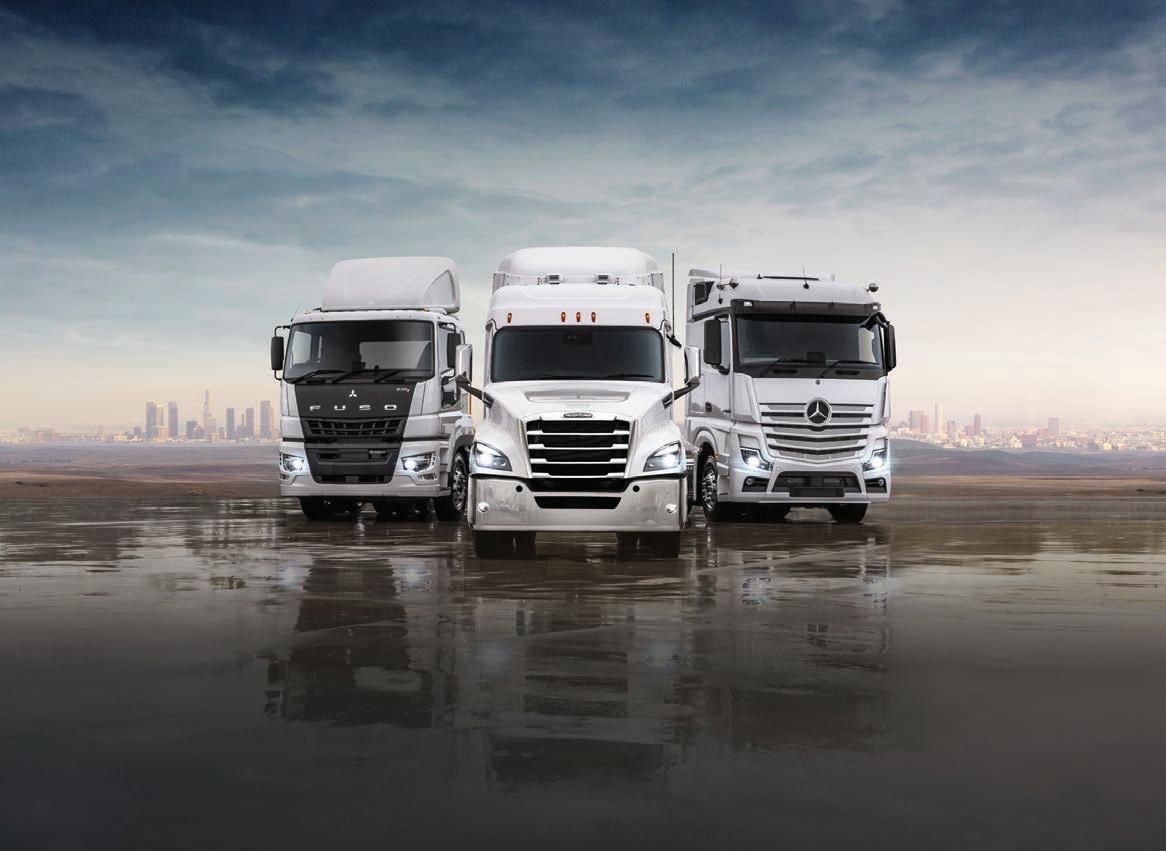
biggest brands have introduced this pioneering truck into their fleet and drivers are reporting just how good zero emission driving can be.
We are gearing up to introduce the second-generation eCanter, as well as the eActros and eEconic from MercedesBenz Trucks. We have thrown everything at their development because we are Daimler Truck and it is what we do. We don’t rush to market. We make sure our product is the best. That’s why these trucks will run efficient eAxles, with no legacy driveshafts or gearboxes left in to add weight. Importantly, they will have our latest active safety features. Going electric might be a bit further down the track for many of you, but when it comes to safety, you can all demand active safety including AEBS now. Please give it a thought when it comes time to replenish or expand your fleet.

Carrying the largest jet fuel spec’d fleet in the country, Hills Tankers possesses over 100 prime movers that it deploys along the northern eastern seaboard servicing airports, mines, retail outlets and military bases.

An airport like Coolangatta is a nexus for economic interests even before a tourist steps off a plane. Hundreds of other service-orientated businesses converge here daily to help maintain infrastructure vital to the Gold Coast whose growing population is no longer strictly a consequence of seasonal activity. In recent years the airport has undergone myriad upgrades to fortify, for instance, its fuel infrastructure as part of an ongoing project to provide it with greater flexibility during peak times and busy periods, which for any world-renowned holiday destination, can surge to many times the customary capacity. An event like the Magic Millions race in January alone attracts 19,000 unique travellers to Coolangatta.
The airport, starting in 2018, underwent an $86 million airside upgrade that expanded the apron 20,000m2 to facilitate four additional aircraft, and a new taxiway. Further reconfiguration of the apron layout since then now allows the flexibility to switch between narrow and wide body aircraft depending on demand. Through a joint venture between Caltex and BP for fuel operations at the airport, 900 metres of new underground hydrant pipe to reticulate fuel, 31 new hydrant points for refuelling, two new underground valve chambers and relocation of all existing aircraft bays along the front of the terminal have also taken place. Surges have made these changes necessary. Hills Tankers, a family-owned fuel carrier, delivers jet fuel on four dedicated A- and B-double units here seven days a week. Earlier this year, it introduced a third generation MAN TGS 540hp prime mover on this run. The new truck has impressed to the point the other three vehicles will be converted to MANs by the end of the year according to Scott Cullen, Hills Tankers Chief Operations Officer.
“The driver acceptance has been outstanding,” he says. “Fuel economy, according to our data, is awesome. They

feature all the latest safety tech and intelligent cruise paired with the Brakematic descent control but they’re also simple to operate. That’s what the drivers especially love about them.”
The third generation TGS 13-litre 540hp is undoubtedly a sophisticated modern commercial vehicle. The Smart Select control module for the 12.3-inch screen of the navigation system and the return to neutral gear selector, are among the notable new features. That said, activating the primary functions can all be done via switch. Operation isn’t made unintelligible through a dependence on a digital interface.
“Some of the OEMs have gone too far with the technology in the cab and the drivers don’t like it,” says Scott. “They’re driving along at 2am trying to work through an electronic screen when they just want to turn the lights on.”
The MAN TGS 540 is part of a recent order that included two new generation MAN TGS 440s that are working on retail deliveries in Brisbane with six more expected later this year and a further seven units due early next year.
“The new 440s are delivering around 2.7 kms/l on the metro circuit which is phenomenal,” says Scott. “It’s the quietest truck our operators have ever driven.”
These trucks are all operating out of Brisbane, where Scott himself is based at Pinkenba. The new site, which is currently under council approval for a $5 million purpose-built facility with an internal wash for tankers, is fast turning into an operational hub. They hope to turn soil by the end of the year.
Scheduling in Brisbane recently expanded to 24/7. Members of the team are shifted on through the night to answer calls and respond to any fatigue incidents brought to their attention via Guardian’s Seeing Eye driver monitoring technology, which is being rolled out across the company. The TG3 MANs were the first vehicles in the fleet to be fitted with it. Drivers, according to Scott, were
 Scott Cullen with Jayme Deves, MAN Trucks SEQ.
Scott Cullen with Jayme Deves, MAN Trucks SEQ.


At nearly 18,000 kilometres into its maiden run, the DAF XF530, one of three new Euro VI prime movers purchased earlier this year by Unanderra Tanker Hire (UTH), is excelling in the areas that count: Fuel economy, driver acceptance and safety. These latest vehicles in the fleet are largely working independent from each other within the business. The first unit in Brisbane is carting laundry chemicals and delivering chemicals to breweries. The other two DAF XF530s have been designated on more traditional tanker tasks.
The Port Kembla-based company specialises in carrying chemicals, something of a kindred application to fuel haulage, but generally is considered an entirely different beast. Demand, not to mention customer expectations, diverge and as a result far less onus is placed on optimising high productivity combinations compared to what the market asks of fuel or even milk tankers. There is little need, given current trends, for multi-combinations. As the fleet must balance the challenges of tight entrances at metropolitan
water treatment plants and waste station sites in regional settings, a semi-trailer remains the best, least compromised option.
The prime mover fleet runs single trailers at 44 tonnes. UTH also delivers smaller loads around Sydney where an 8-tonne or 10-tonne job might require it go into a water treatment plant. The trucks also frequent waste disposal facilities and supply chemicals to leachate plants.
Drivers at these sites are often confronted by problematic access that require trucks to have cross-locks and power-dividers according to UTH General Manager Jeremiah Justice Wiedl or JJ, as he is better known.
“Most of these entry points are just little dirt roads better suited to a 4x4 passenger vehicle,” he explains. “That’s where the big trucks don’t fit. We can make it work using a semi with a compartment of a product and then we’ll leave, reload the semi elsewhere and go away on a long trip.”
Unlike carriers in the cement sector, a chemical hauler like UTH is not always loaded to capacity. That’s because the trips are governed, according to JJ, by the
destination of the customer’s site tank. “If they’ve got a 5000-litre tank, we’ve got to deliver them a 5000-litre load,” he says. “If they’ve got a 20,000-litre tank we’ve got to deliver a 20,000-litre load. Most of the customer storage tanks we do are only taking a single trailer load of product.”
The fleet contains 21 rigids mainly for urban assignments. However, the bulk of the vehicles are prime movers, nearly 60 in fact; and the three new DAFs join another five already in circulation for the Dutch brand. The first of which were introduced following the successful tender of a new contract in 2013 recalls JJ.
“We were looking at buying a DAF CF85 back then, but the dealer offered us a DAF XF105 with an automatic for considerably less than what I wanted in a smaller model truck,” he says. “I don’t recall if it was a product promotion, but we bought two of the larger DAFs initially and it proved a masterstroke.” Still going strong in their tenth year, the DAF XF105s were bigger than what JJ and his team felt they initially needed. Because dangerous goods drivers can
As a niche segment, chemical transportation by road often involves a different mindset to fuel haulage. Unanderra Tanker Hire is one of the industry’s leading practitioners.
carry lots of extra safety equipment, the truck, it was discovered, provided the team with superior storage options. In turn, this led to another advantage regarding fleet utilisation. UTH soon found it could complete smaller jobs challenged by the urban confines in metropolitan Sydney and, then afterwards load up much heavier for regional trips.
“You can live in that truck,” says JJ. “They were more versatile to what we had been accustomed to and that made it possible to maximise our hours with drivers.”

One prevalent area of the business involves transporting hydrochloric acid for the galvanising industry. As these deliveries are usually actioned early in the morning, the flexibility afforded by the DAFs has enabled the driver to reload and trek out, for example, to one of the gold mines in the state’s central west.
“These guys want to earn a decent living,” says JJ. “They don’t want to just work an eight-hour day. They would rather put in a six-hour shift in the morning, do a local delivery and then go on long haul.”
These and other chemicals are also used in the steel industry for preparation processes, for various uses in the mining sector and are crucial for correcting ph
DAF XF530.levels at water treatment plants where it is necessary to drop the solids found in the water. These plants are now located across the country. UTH, in keeping with this, runs trucks in four mainland states. As chemicals are sometimes loaded in places where fuel is also loaded, the application is comparable at least in its categorisation. The trucks also, like fuel haulage vehicles, need to have battery isolation switches installed. Many of the similarities with chemical transport,
however, end there.
“The milk guys and the fuel guys are always looking at optimising payloads and finding the optimum trailer combinations,” says JJ. “We used to have a delivery where we would take a load of hydrochloric acid from Sydney to remote treatment plants outside of Alice Springs. We only went out there with 15,000-litres of product. That’s only 17-tonne.”
It would be unheard of, JJ notes, in the
fuel and milk markets. Working under HML, UTH has provision to load up to 46 tonnes GCM although payload rarely exceeds 25 tonnes.
Business models evolve differently. Often for reasons of timing, economies of scale and sheer necessity. All three have applied to UTH, at different times. Even so, its measured approach to total cost of ownership has made for linear, steady growth. That’s not uncommon either for businesses managed by people with technical proficiency. JJ after all is a mechanic by trade.
“I was brought up to try and maintain things and keep them going,” he says. “That’s always been something dad has emphasised from the start.”
For the family that start takes place in 1980 when Oskar and Wendy Wiedl, JJ’s parents, purchased the business. It was historically established in 1975. Today it remains a family business in the truest sense with JJ’s partner, Belinda, sons Hayden and Joshua, daughter Julianne, and brothers Wayne and Paul, all integral members of the team.
Over the years the company has diversified operations from a traditional liquid waste haulage provider to the chemical transport specialist it is today. That transition was accelerated in the mid-1990s when environmental regulations, designed to crack down on businesses dumping waste illegitimately, created an opportunity for small businesses like UTH which it seized upon. It took well over a decade to expand its working vehicles from a solitary second hand Leyland Reiver to six trucks by the time JJ joined the company.
The truck mix today is varied. As UTH relies heavily on versatility as much as anything, the latest in prime mover technology, as represented by the new DAFs, sits side by side with vigilantly maintained older models, some of which are maturing into a second decade of operations.
One of the big discoveries for the business that helped it choose a

direction was when it realised the aftersales costing of say, parts, was making it uncompetitive in the market.
“We sat down with the accountant, who has been with the business for 15 years and got all the American branded trucks, the Kenworths and Western Stars, and put them beside the European trucks in the fleet and we decided we had to do something to remain competitive,” says JJ. “So, we steered away from the European truck.”
That decision was made in 2008. But changes in traffic conditions and cramped site access of new customers that had been secured, made it evident that sending in bonneted traditional American trucks into these locations wasn’t necessarily the smartest move. “Drivers were having minor accidents and customers were starting to notice our competitors were sending smaller vehicles in,” says JJ. “So that gave us pause. That’s around about the time the first DAFs were purchased.”
The newest Euro VI DAF XF530s are not, unlike some other European brands in the fleet, on contract maintenance schemes. Maintenance of the fleet in the main is performed inhouse. The workshop employs six personnel including a fabricator.

“The challenge with contract maintenance is you need to go back to the dealer,” JJ says. “If the fleet is not profitable, you’re paying a bloke to just sit with a truck at a dealership all the time. That becomes a false saving when you look at the wage component.”

JJ will use external providers, where appropriate, for parts. He often relies on both Gilbert & Roach and Illawarra Truck Repairs & Spares for this and is content with the arrangement.
“Our gear is kept well-presented and maintained. We might downgrade it so it’s not on the same high-profile work or doing the big kilometres anymore,” he says. “If it’s still serviceable, we keep it.”
Being a mechanic by trade informs JJ’s organisational philosophy whereby expertise and resources mean there is
no need to take leave of material reality. Reliability when it comes to good working equipment is not something merely inherited.
“Most of the guys are happy to drive the older gear as long as it’s well maintained,” he says. “You can’t have everything new. Everything gets to an age where you must repurpose it to a different application. This is the thing with the PACCAR product. We’re getting support everywhere. It doesn’t matter where you are you get the support you need. You get the network.”
Diehard Kenworth and Western Star operators, over a beer might joke about driving a DAF in JJ’s experience, but once they do drive it, they “come down-toearth”, to use his words, abruptly. Given where it is they need to go and what it is they need to do when they get there, it can be a rude awakening at first.
“The chief reason is the impossible places we need to get into. You need a conventional truck. You need a truck with a really good turning circle,” says JJ. “They’ve never let me down and the drivers now love them.”
The new Euro VI DAF XF530s, by way of neat coincidence, are made in the old Leyland factory in the north of England, where the first truck of the business was manufactured. With readily available parts and a competitive price point, the new trucks offer him a significantly better cost of life than the other European branded vehicles he has owned.
“I just think the DAFs are far better,” says JJ. “The DAF slogan two or three years ago was ‘Do the math buy a DAF’ and not a truer word was spoken. It all comes down to cost of life of the vehicle.”
Lineage Logistics entered the Australian market in 2019 through the acquisition of Emergent Cold. Through various warehouse acquisitions since, it has completely transformed its operations. Perhaps the biggest change requested and subsequently applauded by customers was the evolution of its national, integrated solution. Lineage Logistics now boasts operational sites in New South Wales, Victoria, Queensland, South Australia and Western Australia — with a fleet powered by 110 prime movers, 130 trailers, 180 refrigerated trailers and 15 tail lift units.

While the Emergent Cold purchase helped address customer needs, it also led to the company solidifying its presence in the Asia-Pacific region. With over 53 million square feet across more than 300 facilities in 12 countries, Lineage Logistics now considers itself the largest temperature-controlled facility network in the world.
In its Australian operations specifically, Lineage Logistics offers a wide range of services for storage solutions, integrated solutions and strategic solutions. The storage option provides clients with cold storage warehousing, port-centric warehousing, automated warehousing, built-to-suit warehousing and sustainable warehousing. Its integrated solutions area includes managed and on-demand transportation services, temperaturecontrolled rail, customs brokerage, freight forwarding, drayage and multivendor LTL consolidation. The company’s strategic solutions offerings, meanwhile, provides
In the latest step in its national fleet renewal program, Lineage Logistics took delivery of ten brand-new Kenworth K200s which are now transforming its linehaul operations.Kenworth K200.
resolutions for food services, directto-consumer fulfilment, supply chain engineering and food processing and manufacturing.
So, in order to continue to back these expanding operations, Lineage Logistics has devised a master plan to get its drivers out of older vehicles and into some new, purpose-built linehaul trucks. “We’re going to be progressing with a multi-year fleet replacement program,” says Director Transport, Australia, Justin
what brands and OEMs we engage with to have as much standardisation as possible across our fleet. Growth will be budgeted and planned as we acquire new customers and continue to grow the business.”
In the last two years alone, Lineage Logistics has invested over $20 million into its fleet with new prime movers and trailers. More recently though, the fleet paid its first visit to Brown and Hurley for ten new Kenworth K200s.

Kenworth track is because it’s a very mature product in linehaul, long haul and in the roadtrain space,” says Justin. “Their proven ability in those sorts of corridors is the most attractive thing about the Kenworth product, and looking back, it’s that reliability that has really benefitted us the most. That’s essentially why we wanted them in the fleet, just to set that standard and get some reliability in our long haul operations.”
Lineage Logistics’ new K200 Aero
550-horsepower X15 engine and Eaton’s FO22E318B-MXP Ultrashift Plus transmission, which has been programmed for better fuel efficiency thanks to Cummins’ Advanced Dynamic Efficient Powertrain Technology (ADEPT).
Rear suspension is covered with Kenworth’s Airglide 450 and a Meritor MT21-165GP Rear Axle with a 4.1 ratio, which has proven its capabilities in Australia for many years.

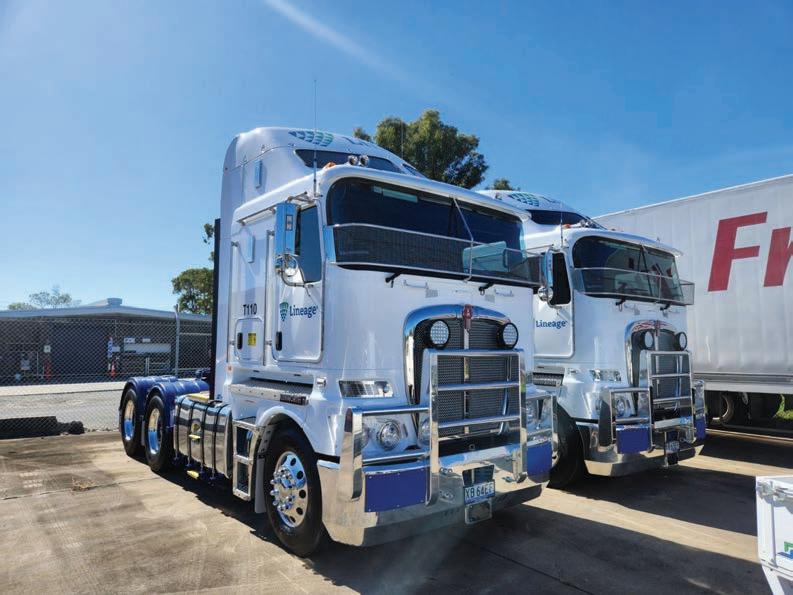
On the safety side, Lineage Logistics’ Kenworths are fitted with a fusion

integrated safety system, stationary vehicle braking, Active Cruise Braking (ACB) with collision mitigation, a full guardian system to help with driver safety, and a JOST fifth wheel hookup sensor system with a monitor dash mounted in the cab to make trailer coupling and uncoupling a thoughtless process.
Although Justin had little previous experience in dealing with Brown and Hurley or Kenworth to go by, he says their ability to meet Lineage Logistics’ lead expectation times, while offering the
fleet everything it could ask for, is what sealed the deal.
“They just gave us everything we needed in our fleet to settle it into a linehaul rhythm without too much fuss, as we didn’t want to recreate the wheel,” he says. “We wanted to make sure that the X15 Cummins matched with the Eaton Ultrashift, and it did making it reasonably seamless. We get a lot of good feedback from drivers around how the transmission and engine communicate, so essentially, we’ve gone to the premium end of what we want for the drivers.”
The new Kenworth K200s have been assigned freight transportation for a range of food producers. It makes for relentless work right around Australia. The B-double combinations (with roadtrain capabilities as well) travel along the east coast to Melbourne and Brisbane, Adelaide to Brisbane and Adelaide to Perth — where in Lineage’s peak periods they will also be running B-triple combinations. The next step, Justin says, will be Performance-Based Standards. While it’s still too early for Justin to compare the new models to his older

vehicles, he has noticed an increased interest in the fleet’s operations by the general public.
“It’s like apples and oranges at the moment because we’ve got such an older fleet, so we really can’t compare them,” he says. “But we’re actually getting some calls because drivers are seeing them and they want to drive brand new Kenworths. There’s a great cohort of drivers out there who just love driving Kenworths, so you attract that sort of linehaul driver in your business.”
As a sidenote, Justin is most pleased
with the outcome of his first transaction through Brown and Hurley. Because of this, Kenworth, he says, will be given top consideration as regards to the remainder of the fleet’s inevitable transformation. “They’ve been very supportive for whatever we need,” he says. “They’re there to help and they have made sure that we are happy right through the process. With most purchases we go back a hundred times with things we want to change and update at the last minute, and they’ve been very accommodating to that.”
Long ago renowned for its Penguin Parade, Phillip Island is a destination for visitors far and wide, many of whom trek from all parts of the globe to catch a glimpse of the seabirds returning home from the ocean. The event is quite the attraction for families around Australia and even the whole world. This has been the case since it began in the 1920s when residents Bert West, Bern Denham and Bert Watchorn opened Summerland Beach for the first organised viewings of the penguins.
Located 142 kilometres south of Melbourne (or a two-hour drive), Phillip Island is a common destination place with over 101km2 of land to explore. In addition to the penguins, Phillip Island Nature Parks offers a range of ecotourism experiences such as the Koala Conservation Reserve, Churchill Island and Nobbies Centre.
New Wave Concreting, a local business, was responsible for much of the concrete work at these locations over the last 20 years. For the Penguin Parade specifically it carried out all of the original concreting on the exterior walkways, external concrete areas and walkways down to the main building where tourists watch the penguins come in. It also completed the concreting for the Wildlife Clinic which included concrete slabs, external paving and the pools and wash bays for the penguins in recovery. With a highly experienced team of professionals with over 27 years of experience in the field, the company specialises primarily in decorative concreting with exposed aggregate and
pebble mix, as well as concrete cutting, steps and crossovers.
“We’re definitely the busiest concreters in the Bass Coast region doing decorative concreting,” says Luke Hinrichs, New Wave Concreting Managing Director.
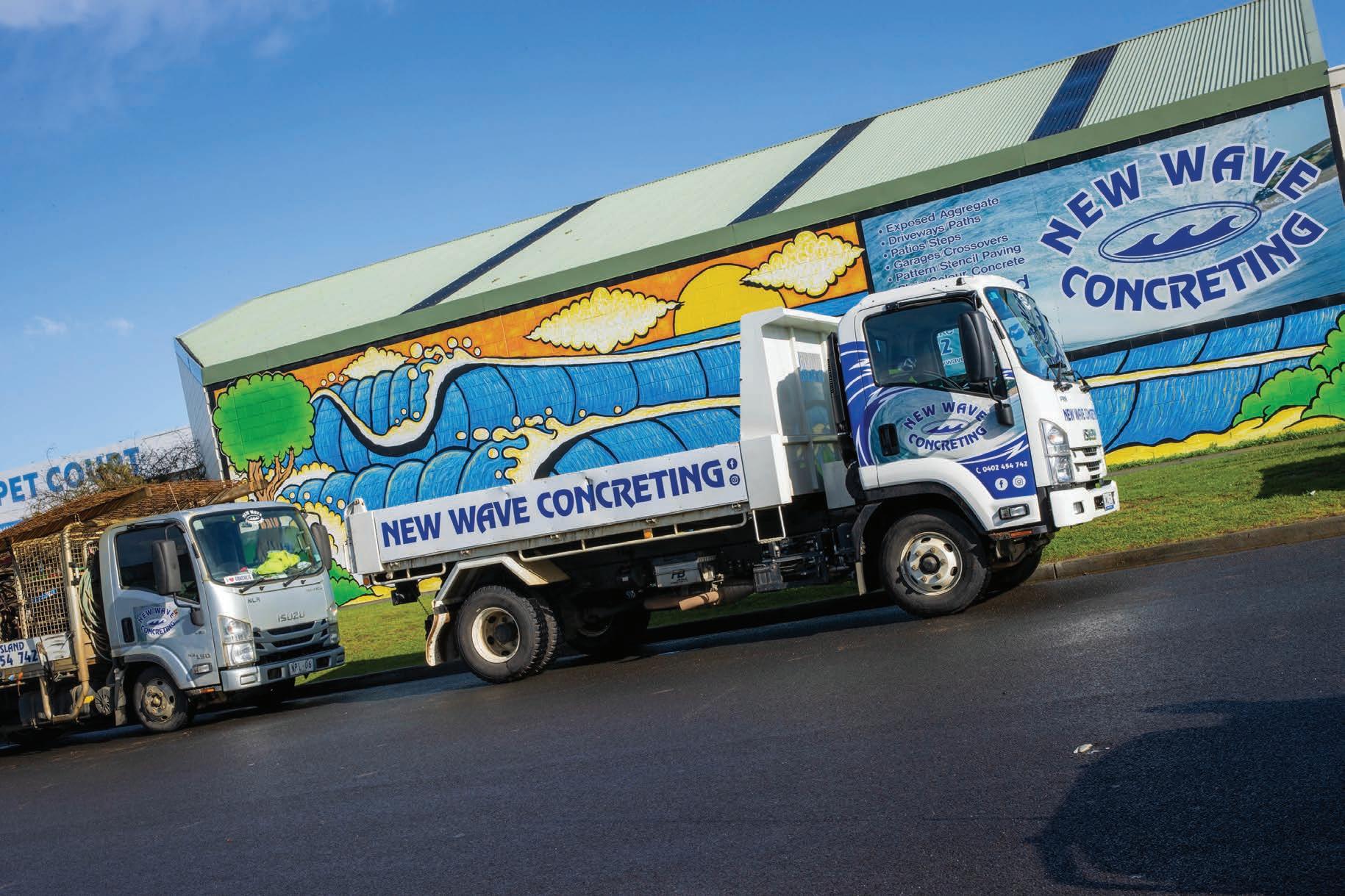
“We are a really good crew made of young family men who run the show while I organise things, which tends to work pretty well. It’s a little bit different to most concreters, especially in this area, that do a little bit of everything. We specialise in the decorative side of things with a wide range of pattern and stencil paving options.”
Pathways in the Nobbies area hug various clifftops providing the public with spectacular views. These were, along with the entryways and bus stop areas at Koala Park and the Churchill Island Heritage Farm, also built by Luke’s team. The farm itself, covering 57 hectares of Phillip Island, is one of Victoria’s oldestfunctioning farms. It dates back to 1872. A range of activities are offered here, including wagon rides, cow milking, sheep shearing and whip cracking, along with a farmers’ market that features over 40 stalls selling local produce from the Gippsland region.
New Wave Concreting’s next big project, Luke says, is the community centre being built in Cowes which will require up to 600m2 of exposed aggregate. Aside from these jobs, the team plays a part in a series of community work as well by being involved with all of the local golf clubs in San Remo and Cowes and sponsoring the local football clubs.
To establish New Wave Concreting and make its services available to Phillip
Island in 2000, Luke purchased his first truck, a second-hand Isuzu, which is now over 20 years old. Although he sold it to another local concreter at a later date, it is still running today. This, Luke says, has cemented, you might say, his trust in Isuzu.
While it may come as a surprise to some, the Phillip Island Penguin Parade and Isuzu both have one thing in common.
from Isuzu which he still runs daily.
“Originally I just felt that their salesman
and sales tactics.”
Luke signed up for the truck on the
else,” he says. “I was that happy with his customer service. He just told me how it

is, what he had available, what he could get and when it would arrive. Everything he said he would do, he did. I’ve recommended him to other people as well, and they’ve all said the same thing. They were really happy with the result — I’ve had mates buy similar trucks with the exact same story.”
The new Isuzu, a 2022 FRR Tipper, is mainly operated by Luke. Compared to the fleet’s previous units, it’s much bigger, bringing noticeable improvements to productivity.
“It has really helped with how much work we can get done in a week, as the dig outs have halved in time,” Luke says. “It’s far more useful having that slightly bigger truck. So, it’s really sped up dig out times and has allowed us to get more done each week.”

The most important feature Luke found on the Tipper was its size. Before purchasing it, he says, he had no idea of
how effective a slight upgrade from a car license tipper to a truck license tipper would be.
“The overall running cost is a lot better too, because the truck’s not doing the amount of trips we were doing previously,” he says. “Although it’s a larger vehicle, what we were doing in three trips we can now do in one.”
Some of the sites the team encounter have only limited access. Anything larger, therefore, would have struggled to get into the areas they do work says Luke. “Nature parks and limited access tracks are common to us,” he says. “It was a nice compromise size-wise between larger models and what we already had.” Performance-wise, New Wave Concreting hasn’t had any problems with its two Isuzus. In fact, Luke says the drivers absolutely love them. They have made a big difference running day-to-day, and they’ve caught the eye of the general
public as well.
“They are head-turning vehicles,” Luke says. “We do get a lot of people that see us working and the vehicles all signed up, and they’ll come over to get a number or a card. They do get attention through the public, even at petrol stations, being signed up right.” In the long run, choosing Isuzu has proven beneficial for New Wave’s operations. The FRR Tipper and its siblings have shown that they can keep up with the daily workload, and because of this, Luke believes Isuzu is ahead of the pack.
“I don’t know if anything else can compete, it’s just bullet proof,” Luke says. “It’s spot on, and for what we do, I couldn’t fault it. It really is perfect for our running day-to-day. And we do give them a hard time, that’s for sure. They definitely do the work, and they don’t miss a beat.”
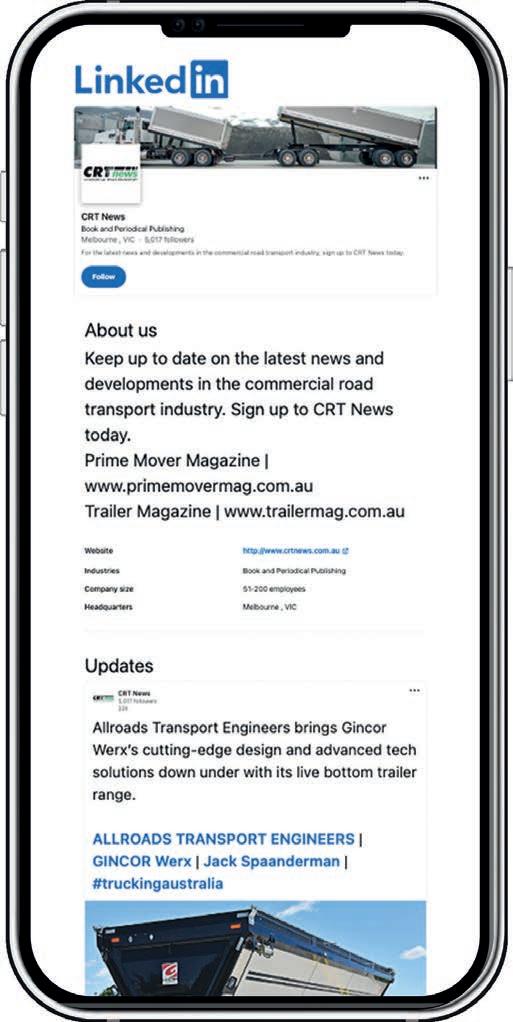
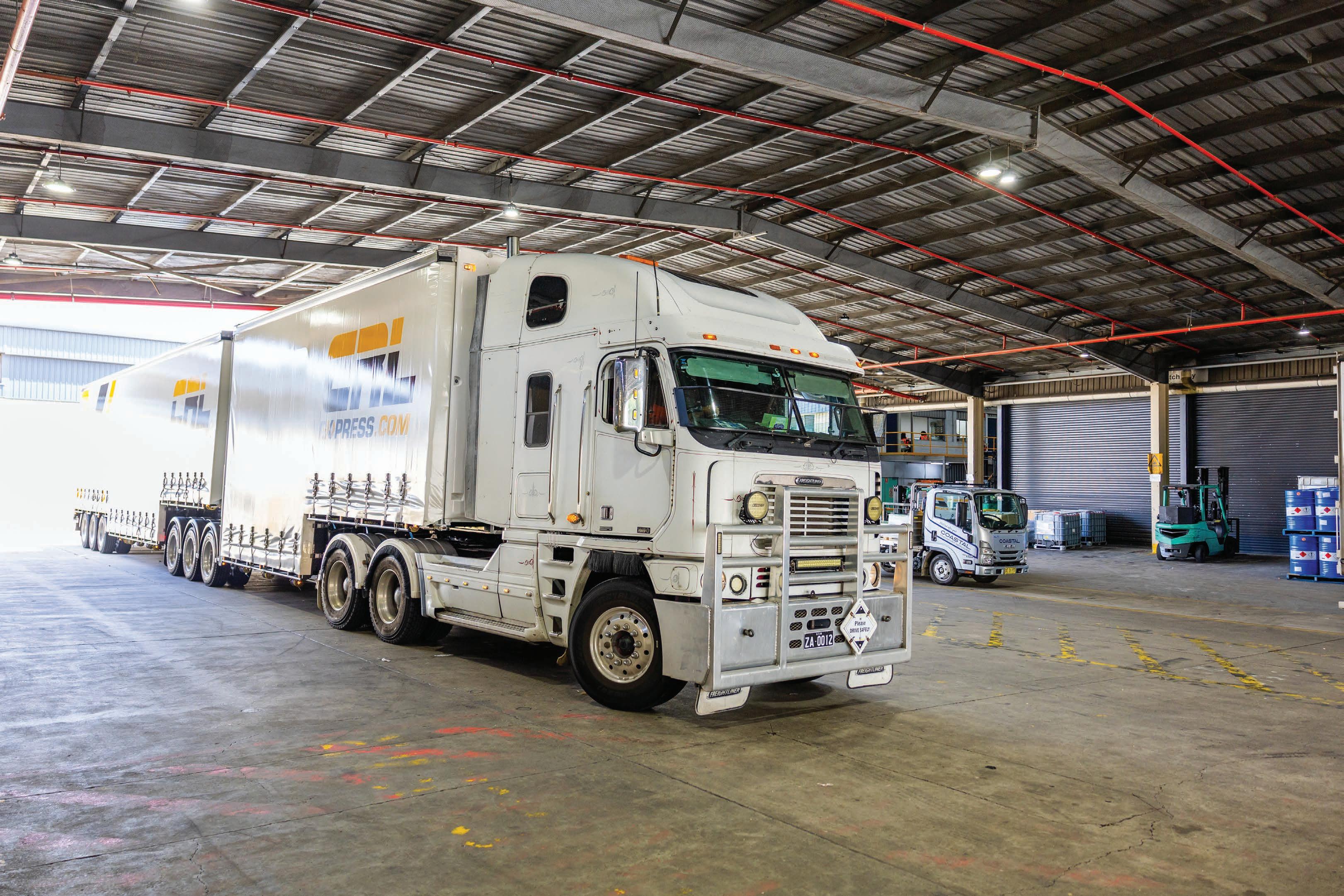
Founder and Managing Director Roy Kazamias endured a few false starts before he got his company, CRL Express, where he wanted it. That would be, at least for the moment, as an agile and efficient 3PL provider on an imminent growth journey. The business has officially been trading for a little over a year, although it was registered in 2018, while Roy, who had found demand as a logistics consultant, set about putting the pieces in place, initially as a niche linehaul operation during a time of great upheaval in the industry not typically conducive for launching a transport startup. The first delivery for a customer in Newcastle occurred in September 2019. That all ultimately amounted to stalled but real progress.
CRL Express (the first two initials in the name derive from Roy and his father Con, who serves as 3PL Manager) offers door-to-door services, break bulk pallets, accommodates storage, ecommerce and provides niche transportation in dangerous goods shipments and difficult-to-move, fragile or oversize freight that doesn’t fit the purview of a carton or standardised pallet.

A relative newcomer to the freight-forwarding segment, CRL Express is looking to build its brand as a dynamic mid-tier business “large enough to handle,” as its motto goes, and “small enough to care”.
This remains an area of targeted growth while the general freight services continue to tick over according to Roy.
“Right now we’re seeing rapid growth,” he says. “While some of that is unexpected, we have real provision to manage and encourage that trajectory.”
Proof of that can be seen in Dandenong South where CRL Express only recently opened a brand-new facility. The 11,500m2 facility features over 7,000 pallet bays of racking and a 2,500m2 super awning to facilitate all-weather cross-docking and operations. For the next six months

Roy will travel between Melbourne and Sydney while that location is brought up to speed. Speed, after all, is key. It underpins not only the expansion of the services offered but also its mounting portfolio of customers. In a relatively short space of time the business has attracted major partners including Krueger, TransVirtual, BP, Ampol, CartonCloud and Snap.
Oversized bulk deliveries for the B2B sector have fast become a major income stream for the company particularly in the specialised cargo distribution for bicycles, bathroom vanities and textiles.
“That’s something we are doing a lot of, and we do it well,” says Roy. “No one really wants to handle these items given they can’t be delivered on a skid or a pallet.”
The business also offers express deliveries around Australia in standardised pallets.
“As we grow, in order to find economy of scale and efficiencies within our own network, you’ve got to really stick to what you specialise in,” says Roy. “No longer can you be an all-in-one transport company. I think the market has also changed drastically. There’s a great gap in between your top tier companies like your Tolls and your TNTs and then your mid-tier companies.”
That gap, according to Roy, is why customers are increasingly preferring a more personal service.
“They’re not chasing someone through a call centre in Singapore,” he says. “Their data doesn’t get leaked around the world
and the potential threat of cyber security attacks is not a major concern.”

There exists a fine line, at least in the top tier, between transport companies that haven’t sacrificed that personal service on the altar of growth.
“That personal service really comes down to what you specialise in and how you set up the business itself,” Roy says.
CRL Express, at present, employs 35 people directly in addition to using the services of around 80 contractors. It currently oversees 2000 consignments a week. Delays across the supply chain, which became endemic industry-wide even before the business attempted to grab a foothold, forced its hand and a decision was made to focus on controlling the network and outsource mobile assets, where possible,
company-owned equipment.”
That said, the fleet does currently have five prime movers on order. These consist of four new Kenworth T610s and one Volvo FH540. They will pull either B-double double drop deck or single drop deck mezzanine trailers. The most prolific application in the fleet is the 4-tonne curtainsider. In locations where access for a standard rigid is prohibitive, they have contractors who pilot smaller vehicles. These circumstances, however, are the exception rather than the rule.
“We are committed to further enhancing our company’s assets through the procurement of new Kenworth T610 trucks, expected to be ready for operation in 2024 and 2025, complemented by trailers from Krueger and Vawdrey,” explains Roy. “As part of our strategic fleet management approach, we aim to achieve a fleet ratio of 60 per cent company-owned vehicles and 40 per cent contractor-operated vehicles, aligning with our longterm objectives.”

to third parties. Roy cites his business is a mix between company assets, ownerdrivers, contractors, and agents. The agency network covers other areas like Perth, Brisbane, and Adelaide, so that CRL Express is represented in all the major cities recognised for freight-forwarding on the eastern seaboard.
“I have a strong belief that if you focus on trucking itself the logistics department falls down,” says Roy. “You take away attention from logistics. You’re not focusing on how you grow that service. The focus then becomes about replacing contractors with
The more recent investment in modern equipment reflects a renewed dedication to maintaining a robust and reliable fleet. Roy believes the aim of which is to enable CRL Express to deliver superior services to its clients while optimising operational efficiencies. To strengthen its management structure, the business has recently welcomed a leadership team as it looks to enhance financial capabilities and overall performance. In support of this move, the company is actively recruiting multiple account managers to reinforce its sales and customer engagement efforts that it anticipates will sustain the ongoing success of the business.
“By expanding our team with qualified professionals, we aim to further improve our services and provide enhanced support to our valued customers,” says Roy. “Our vision is to provide unsurpassed service in the logistics sector and offer our staff members a workplace like no other.” He adds, “We’re determined to realise that.”



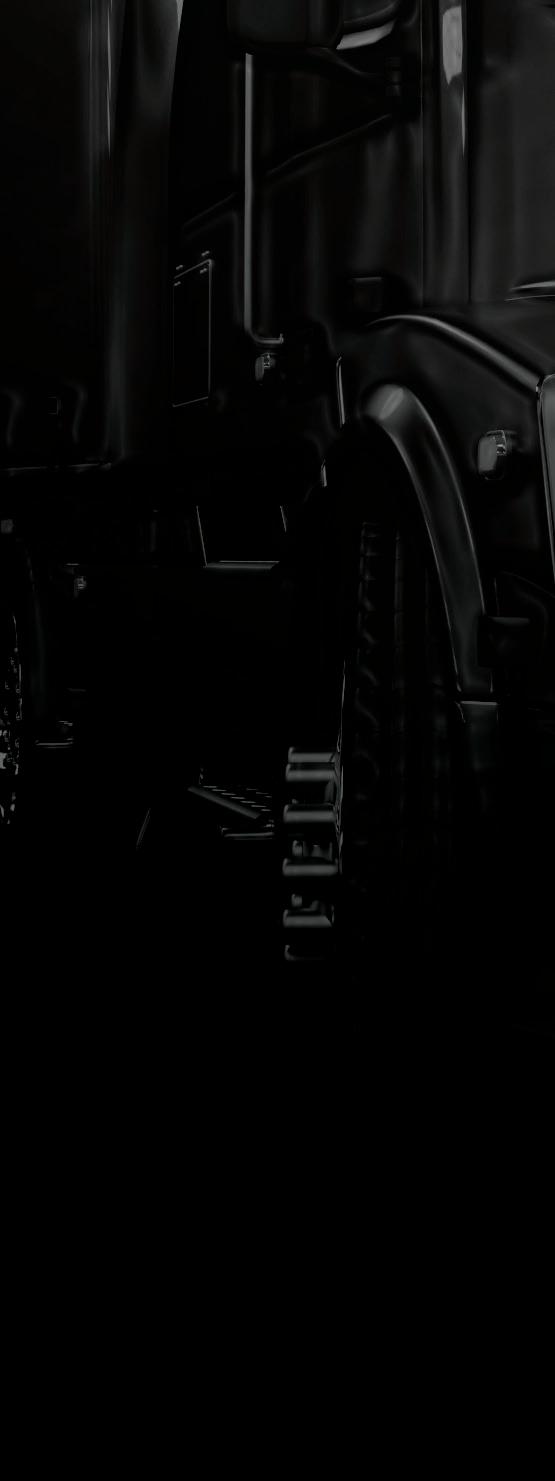



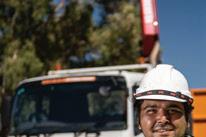


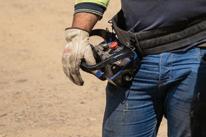




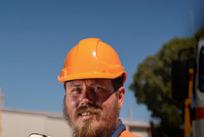




Hino has reaffirmed its commitment to its hybrid diesel-electric trucks and with over 700 hybrid-electric trucks already on Australian roads, Hino has been gaining local experience in low-emission trucks for more than 15 years. The Hino 300 Series hybridelectric light-duty range draws upon technology from the wider Toyota Group which has been proven in millions of its hybrid vehicles worldwide.
The Hino 300 Hybrid incorporates what is now a mature technology with no recharging requirements and its range is not affected provided diesel fuel is available.
As road transport globally heads towards a net zero emission future, Hino’s Hybrid is immediately able to provide a sizable reduction in diesel fuel consumption with a corresponding reduction in emissions. Overseas, Hino continues to work on its Project Z battery electric and hydrogen fuel cell trucks for light and medium duty applications and late last year Toyota completed its joint venture exercise with PACCAR to develop heavy duty trucks powered by hydrogen fuel cells.
“Our hybrid-electric models meet Euro VI exhaust emission standards and recent real-world trials comparing the Hino hybrid-electric truck against a traditional diesel equivalent revealed a 22 per cent reduction in fuel use and CO2 emissions,” says Daniel Petrovski Manager-Product Strategy Development at Hino Motor Sales Australia. Rising fuel prices and an increased focus from customers wanting to minimise their environmental impact has seen sales of Australia’s only hybrid-electric light-duty truck increase significantly and Hino has expanded the range of hybrid-electric products to include new Alloy Tray and TradeAce built to go models. Greater savings are achievable depending on the application of the hybrid vehicle and how it is driven. Hybrid electric operators also benefit from a reduction in maintenance costs as the electric motor replaces the diesel engine’s starter motor and alternator, and the regenerative braking reduces the use of service brakes and increases the life of the brakes, all while charging the Hybrid batteries.
“Hino 300 Series Hybrid customers can reduce yearly maintenance costs by up
to 16 per cent,” says Daniel Petrovski. Technically, the Hino Hybrid system uses a lightweight Power Control Unit (PCU) which encompasses the battery, inverter, Engine Control Unit (ECU) and DC-DC Converter. The Hino four cylinder common-rail injected turbodiesel engine produces 150hp (110kW) and 470Nm of torque. This is delivered in combination with the electric motor, with maximum torque available at a very low 1200rpm, making for a major contribution to the trucks’ fuel efficiency.
In common with the rest of the Hino range, the Hino Hybrid now is equipped with Hino SmartSafe which is a comprehensive safety package with advanced driver-assist technology. It includes a Pre-Collision System (PCS) with Autonomous Emergency Braking (AEB), Pedestrian Detection (PD) and Lane Departure Warning System (LDWS). This is in addition to Vehicle Stability Control (VSC), reverse camera, dual SRS airbags, four-wheel disc brakes and hill start assist.
As part of its commitment to provide customers with its innovative Hino Advantage business solutions, Hino
Hino has set a course embracing the latest in commercial vehicle technologies, while also committing to its hybrid-electric developments.
Australia is upgrading the multimedia unit across its range of light, medium and heavy-duty trucks, with a phased rollout starting from July 2023.
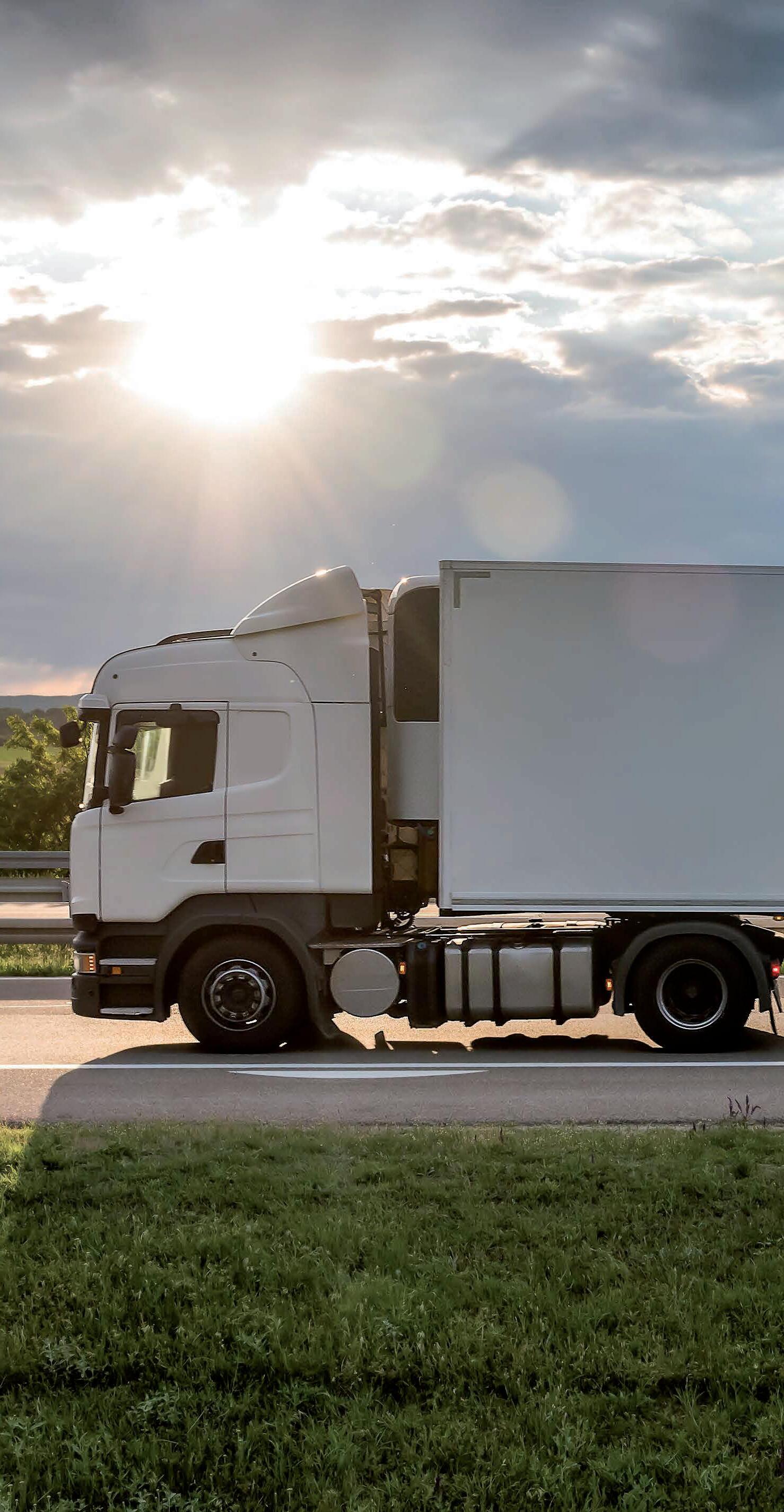
Following the success of the previous multimedia unit, Hino has once again partnered with Melbourne-based Directed Electronics in the development of the latest unit, with a particular focus on driver and vehicle ergonomics.
“Simplicity in the ‘driver-machine’ interface design provides enhanced functionality and selection for drivers courtesy of items such as a volume control knob, buttons on the unit and programmable control buttons on the steering wheel,” says Daniel. “We know that drivers’ lives and businesses are progressively more dependent on being connected and contactable, and are undeniably intertwined with their phones, which is why the new multimedia unit features wireless Apple CarPlay and Android Auto phone compatibility.”
Other changes include improved Bluetooth functionality and microphone performance, plus an easily accessible 2amp USB fast charge point at the front of the unit. The truck specific navigation system can be tailored to suit each individual truck or load, with the ability to input critical data such as the truck’s height, weight and dangerous goods classification.
The navigation system then calculates a route that avoids low bridges, weightrestricted roads and/or dangerous goods-restricted areas. The new multimedia unit will provide all vehicles with the capability to access the full suite of Hino-Connect business telematics features.

Currently standard fitment on the Hino 700 Series and 500 Series vehicles, and now available as an option for 300 Series, Hino-Connect is the nextgeneration of business intelligence which provides customers with realtime performance data tracking, remote
diagnosis of vehicle faults and dedicated Hino-Connect specialist support. Developed in Australia in conjunction with Directed Electronics, Hino-Connect allows direct communication with the driver through the truck’s multimedia unit, which is an Australian-first. Fleet managers are able to use an online portal and mobile app to access business intelligence and real-time insights into their fleet including live vehicle performance data such as fuel usage, the cause and effect of driving performance, and safety alerts.
The June announcement that the Daimler-owned Mitsubishi Fuso Truck and Bus Corporation (‘Fuso’) and Hino will merge on an equal footing and collaborate in the areas of commercial vehicle development, procurement, and production, will turbocharge the development and adoption of technologies for both brands including hydrogen fuel cell powertrains and autonomous commercial vehicles.





Only a few short years ago the figure of 10,000 new truck sales annually seemed wildly ambitious. Yet Isuzu is tracking well enough to potentially surpass 14,000 units into the Australian market during 2023. Should it do so it will also mark the brand’s 35th consecutive year of market leadership.
The company has a clear vision of utilising practical innovation to maintain its leading position and has the strategies in place to back this up.
“Post-pandemic the performance of the market, the demand for road transport solutions and the confidence in our sector have been nothing short of remarkable,” says Isuzu Australia Limited Director and Chief Operating Officer Andrew Harbison. “It’s not enough for us to focus on being number one. We are continually challenging ourselves and striving to be the best in the totality of our relationships and our offer to the Australian road transport industry.”
Recognising that developing and selling its
trucks are but the early steps in the longterm journey, Isuzu is revamping its Isuzu Care customer support program. “We talk amongst ourselves until we are blue in the face about the importance of supporting our customers both before, during, and after the sale,” says Andrew. Connectivity is emerging as an important element as trucks move further into the era of e-mobility and it is through a connected vehicle that owners can fully realise the operational insights and efficiencies available from their trucks and Isuzu has
been incorporating sophisticated electronic hardware with the necessary software to enhance the management of fleets as well as individual vehicles.
Integral with the design and development of current and future models, Isuzu will consider four key factors: carbon neutrality, driver comfort, safety, and connectivity. During the next few years Isuzu will make available a portfolio of powertrains from Battery Electric and Fuel Cell Electric to hydrogen internal combustion. For its low and zero emission vehicles it is imperative to strike the balance between being environmentally responsible while remaining financially viable.
Isuzu revealed its new look N Series and F Series ranges in Japan back in April, featuring the first new major cab designs in 17 years, and included the first of its OEM-developed electric vehicles which use modular technology to utilise between three and five battery packs. On display in Brisbane was the Japanese specification electric N Series and Isuzu has made it clear that locally its initial foray into the EV market will be for a heavier 4,5007,500kgs GVM with an operating range of between 150-200kms making it suitable for last mile deliveries and local government applications. Local trials of the EV models are scheduled to commence in the fourth quarter of this year.
Arrangements to jointly develop and share technologies is becoming more common among global OEMs and Isuzu and Honda will collaborate to supply a fuel cell system for a heavy-duty Isuzu truck planned to be introduced to the Japanese market in 2027.



Another example of joint venture outcomes has been the announcement of the new Isuzu and UD Trucks collaborativelydeveloped prime mover. This is the first truck developed since UD joined the Isuzu organisation in 2021 and was recently released in Japanese domestic specification. We can expect to see the progressive release of similar products across other markets including Australia in due course.
Noteworthy, this is the first time the Volvo 13-litre engine has been available for either an Isuzu or UD branded product. The power and torque ratings of the 13-litre engine, combined with the Volvo Group I-Shift/ESCOT automated manual transmission, and Japanese build quality, should be very suitable for applications in Australia including in 6x4 prime mover configuration. These trucks will be available in Japan later in 2023 and will be sold under both brands, and consideration is currently being undertaken to assess what will be the best case for distribution in other markets, including Australia.
“The clear strategy from the global point of
view is the best way to get the best product is to work together on delivering a product that shares basic driveline fundamentals,” says Andrew. “How we differentiate that is being worked through. We’re very keen to have the 13-litre.”
It’s one thing to get the hardware right but customers now expect a higher level of support for their vehicles. Recognising this, Isuzu engaged in extensive research about customer expectations, particularly in relation to Isuzu Care which was launched in 2006. This acknowledgment of the importance of its customer support program has proved to be a differentiator and enables Isuzu to claim a superior total solution offering to the market. During 2023 a national training update involved every Isuzu dealer principal, along with every care specialist, sales, service, and parts managers across the country. This program has been supported by web-based training for all remaining staff to ensure that everyone who wears an Isuzu badge has the right Isuzu Care approach. “There is certainly plenty going on globally,” says Takeo “Tak” Shindo Managing Director and CEO of Isuzu Australia. “The world has changed significantly, so has Isuzu. The Isuzu brand has never been in a stronger position. We are choosing our future and I can assure you it is very bright.”
With the 3G shutdown fast approaching, next-gen telematics provides a way to increase compliance, reduce costs and enhance driver, and road-user safety at a very low cost.
No technology is perfect, and, after a while, it becomes outdated. With the 3G shutdown fast approaching, now is the time for operators to update their telematics to the latest 4G and 5G-equipped tech.
Telstra will close its 3G network in June 2024, less than 12 months away, but the shift to 4G and 5G has a lot to offer operators, including more speed and connectivity, along with opportunities

to streamline and improve efficiency. Teletrac Navman, according to its Chief Product Officer Andrew Rossington, can help make the switch easy.
“There are many variables outside the control of fleet operators like road conditions, weather, animals, and other road-users,” he says.
“Where technology like telematics comes into play is in enhancing safety, providing opportunities for driver coaching and development,
and improving compliance with government regulation.”
Cost should be no barrier, as Andrew views it, to improved compliance and safety.
A common misperception regarding telematics technology is that it’s expensive and generates little or no safety benefit for drivers and other roadusers. Like all technology, the cost of telematics is decreasing and continues to decrease as it improves.
An IBM PC, to cite an example, costs the 2023 equivalent of nearly $3000 when it was launched in 1981. Now you can buy a computer which outperforms that original desktop by orders of magnitude for a couple of hundred dollars.
In real-world terms, however, the cost of telematics is negligible compared to other inputs like fuel, maintenance, wages, and insurance says Andrew.
“For the typical interstate operator, Teletrac Navman’s telematics solutions works out to cost around 1.8 cents per kilometre, all the while providing access to increased productivity, Smart OBM, electronic work diaries and paperless objective evidence, among other benefits,” he notes.
That’s before accessing the latest in AI camera technology, as well as proactive risk mitigation, and the ability to manage compliance by exception.

Teletrac Navman’s telematics solutions, as another added benefit, don’t have any upfront costs.
While telematics, as Andrew maintains, can’t control variables like the weather, road conditions or other road-users, it does provide a direct safety benefit by monitoring driver behaviour and equipment performance over both the
short and long-term.
“For operators, this means having the ability to mitigate risk,” he says. “Telematics can’t force a change in driver behaviour, or ensure businesses are running their operations safely. Having telematics in place certainly doesn’t mean you’ll be running a 100 per cent safe operation — there are too many variables outside operator and driver control, and technology can’t replace skill and good judgement.”
What it does mean, however, is managers and operators now have the tools and the information at hand to see what needs to change, and then, proactively, make those changes.
Telematics, for instance, can provide insights into driver behaviour and managers can use this information to inform their coaching programs. It also allows preventative maintenance, avoiding potentially dangerous on-road breakdowns.
“The driver behind the wheel also benefits because they’ll be alerted to risks like distracted driving, speeding, harsh braking, and a close following distance,” says Andrew. “These alerts then let the driver respond in the moment to reduce the risk of an incident occurring.”
Sometimes things do go wrong. That’s a reality. And if they do, telematics, according to Andrew, has a vital role to play by allowing managers to communicate with their drivers, get their location in real-time and direct emergency services to their location if needed.
“This constant communication is a critical safety benefit, and one which shouldn’t be overlooked,” he says. In
fact, it can pave the way for improved compliance and reporting.
The road network is, obviously, critical to the transport sector and telematics provides the tools government agencies and industry bodies need to offer assurance around heavy vehicle access to the network.
Real-time OBM weighing systems, for example, measure the mass of axle groups and calculate gross vehicle mass, while TMA records important positional information, providing valuable insights into truck movements.
The latest OBM and TMA technologies allows operators to reduce costs and improve their return on investment according to Andrew.
“It means operators can move more with less and run their trucks at higher mass limits, improving productivity, creating fewer trips for drivers, as well as reducing CO2 emissions and an increase in safety,” he says. “While costs are at the forefront of operators’ minds every cent counts.”
Technology can promote rewards for drivers, whose individual safety scorecards can be cause for celebrating safe driving and allowing the creation of improvement plans which will have a tangible impact on reducing overall risk. Telematics, after all, isn’t just a compliance necessity. It’s also a valuable tool to improve driver and road-user safety. While risk, Andrew acknowledges, can’t be completely eliminated, telematics provides the means for operators to mitigate risk, creating better outcomes for everyone.
“With the 3G shutdown approaching, now is the time for fleets to update their telematics,” he says.

The appetite for new and innovative truck technology extends well beyond those in or adjacent to the industry as was verified by this year’s Brisbane Truck Show. Overall attendance for the event held in May was over 15 per cent higher than any previous occasion with 42,855 people passing through the doors of the Brisbane Convention & Exhibition Centre. Here 16 commercial vehicle OEMs representing some 23 brands gathered to showcase their latest products over a frenzied four days. To properly see all of it in any less time, as countless attendees will attest, is next to impossible given the range and volume of products and services on offer.
of surprises, that have set tongues wagging long after the final exhibit was bumped out.
There was no need to go in search of somebody impressed by the DAF XG+ 660. You could usually hear them.
Developed in Australia by the PACCAR engineering team at Bayswater, it features a 15-litre Cummins engine. As the biggest of the European cabs this truck had a notable presence at the popular PACCAR stand, where plenty of interest was also generated by the DAF XF H+, a hydrogen fuelled truck powered by an internal combustion engine. A DAF LF electric distribution truck, with a 260kW electric motor, offering range of up to 280km, made certain the Dutch marque


The biennial Brisbane Truck Show gathered together an all-time high presence of original equipment manufacturers, who were greeted by huge crowds, the likes of which had not been seen before.Isuzu N Series Electric Vehicle.
the present and future proudly displayed its TOYA award winning K220 with Endurant transmission, its latest offering built specifically for the local market. Australian carriers were given a peek at the Kenworth T909 with 50-inch sleeper; a T610 with 55-inch sleeper; and both a T360A and T410SAR in low roof car carrier configuration. PACCAR also made use of the event to showcase vehicles it has developed in California including a Kenworth FCEV T680, conceived as part of a joint venture with Toyota. It was flanked by a HFCEV 630hp electric motor in which 60kg of hydrogen is stored at 10,000psi. Kenworth claims it provides a range of up to 480km with a 15-minute refuelling time.
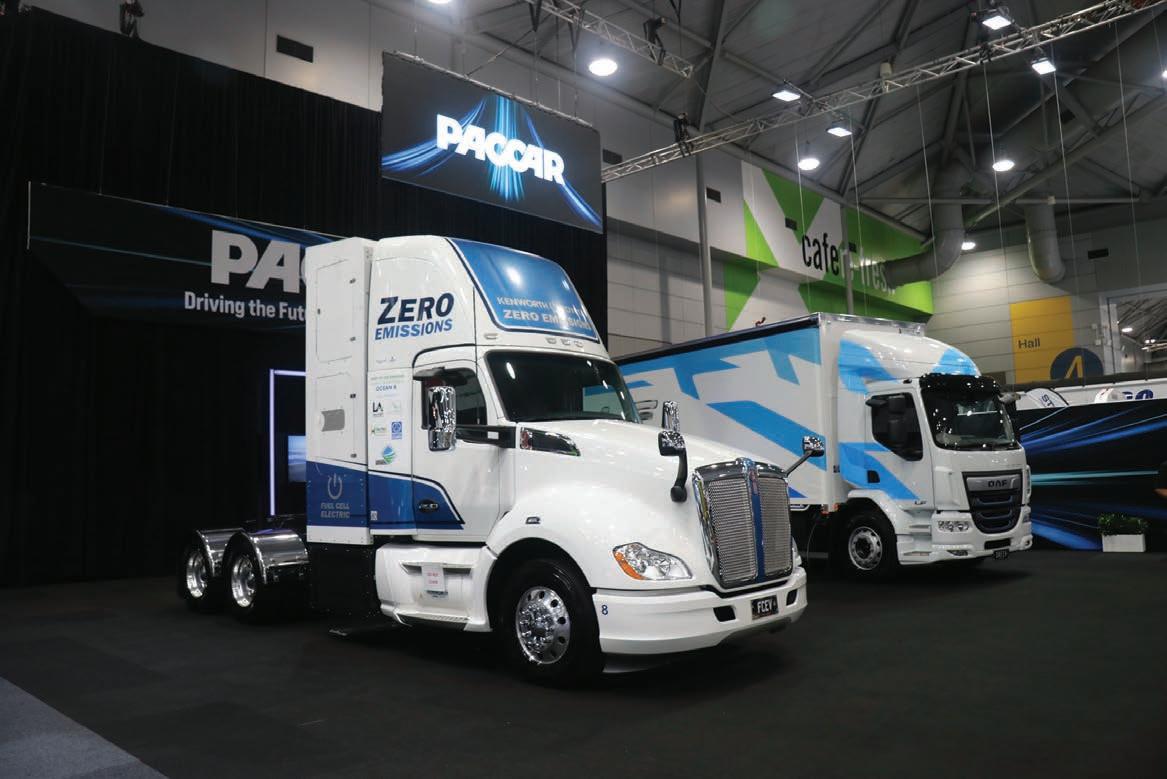
Heavy-duty rival Volvo Trucks was not lacking for battery electric vehicles either with EVs and local manufacturing serving as the major focus of its stand this year. With Global Executive Vice President Roger Alm in attendance, the Swedish brand wowed with a stunning neon yellow FH16 XXL cab. To better illustrate improvements to air flow, it boasted
several notable visual touches including mirror arms and closed up panel gaps and wheel arches. If Miami Vice was about trucking this is what Don Johnson would drive.
In the future fuels space, Volvo promoted internal combustion engine vehicles using HVO fuel, which, according to the OEM, offer a 95 per cent reduction in greenhouse emissions. The exhibit also displayed a Volvo FM electric and a FE rear loader EV. Sister company, Mack, celebrated 60 years of manufacturing in Brisbane. Part of the festivities included a world record Lego model Anthem and a range of new sleepers on show, not forgetting its 36inch integrated walk-through sleeper cab. This vehicle is optimised for 34-pallet B-double application. It is powered by a 13-litre MP8 with M-Drive HD 13-speed. The biggest sleeper Mack offers, a 70inch walk-through sleeper for roadtrain applications, attracted strong interest. Powered by a 16-litre MP10 685hp engine, it uses an M-Drive XHD 14-speed transmission with 2 reduction gears.
In a world first, UD unveiled a CG Quon 8x4 agitator fitted with an ESCOT AMT. Its full safety package includes driver monitoring, blind spot detection system for objects and vulnerable road users covering both sides of the vehicle (30 metres to the rear and 7 metres to front). UD also made a splash with an extra-longwheelbase CG Quon, its first 16-pallet curtainsider.
Truck sales leader Isuzu provided a compelling reminder that it had celebrated its 50th anniversary in Australia last year, a milestone very much still front of mind at the company. On display was one of its first factory produced BEVs. Continuing this theme, the OEM exhibited an N Series EV spec’d for Japan that in likelihood will be different when launched for local customers. It will target a gross vehicle mass between 4500 and 7500kgs in Australia. Operating range is estimated between 150 to 200km. Initial customers Isuzu will target are certain to include local government councils. Dual control refuse compactors were a focus of its legacy powertrains. Its
offering included an FYJ 300 350 twinsteer agitator, N and F Series tippers while it signalled an intention to support its popular Ready to Work range in curtainsider freight packs.
Mercedes-Benz turned more than a few heads with a new generation eActros, something of a flagship for its transformational task of electrification. It uses two electric motors with a maximum output of 442hp. Three battery packs come as standard with an option for a fourth. As the Actros has now been around for 25 years, to honour the successful truck platform, Mercedes-Benz announced a limited release Actros 25 Driver Edition with space cab and a host of integrated special features. A fuel efficient 13-litre engine will offer up to 4 per cent improvement in fuel economy.
The Mercedes-Benz eEconic waste collection vehicle was another of the brand’s key offerings at the show. Given the increasing demand for quiet functioning vocational type vehicles, the refuse truck will suit urban areas due to its impressive low noise output.

Daimler’s bonneted American brand, Freightliner made the most of the occasion by highlighting the versatility of the Cascadia, available to order in either a Detroit DD13 or DD16. Both of which are now suited to the 34-pallet application. Additionally, the Freightliner Cascadia 116 is offered as a 36-inch cab B-double and as a 16-litre 36-inch tipper. A colossal Cascadia 126 spec’d as a roadtrain with a 60-inch cab turned a few heads. Daimler’s Assurance safety package is standard across the range. The Cascadia is also the only bonneted heavy-duty truck in Australia to have drivers’ air bag as standard. Freightliner also called to attention the new DT12 transmission. Not to be outdone, Fuso displayed the new Shogun 510, the most powerful Japanese truck in the market. One key exhibit of note was the Shogun tipper developed exclusively for Australia and New Zealand.
In the zero emissions category, Fuso gave many punters their first look at the new next generation eCanter. The second generation eCanter is available in a
broader range than the previous model that debuted at BTS in 2017 and now uses an eAxle. Fuso made it known that it could be charged with conventional AC power.
As to be expected, Western Star was committed to promoting its new X Series range with the 47X, 48X and 49X, present, all with either DD13 and DD16 power plants. The other non-municipal heavyduty truck available through Penske
Australia was the new generation MAN, launched in August last year. It offers a 250hp small cab right up to 640hp sleepers. A Euro V1 510hp 6x4 and a 640hp big cab new truck generation among the variants were two to look out for.
The major focus for Hino Australia was its expanding range of hybrid vehicles. [See more on page 50].
Korean automotive powerhouse, Hyundai, is looking to enhance its profile in Australia with the Hyundai Mighty Electric with a range of factory bodies available including a fridge van. Ten truck dealers, rather than car dealers, have signed up so far for the EV which offers around 4 tonnes of payload at a range of 200km fully loaded and rated to 7.3 tonne gross vehicle mass.
IVECO had its own electric vehicle, known as the eDaily on display. The 70C cab-chassis with a 4350mm wheelbase is equipped with three batteries that form the basis of local engineering and
application assessments. The new IVECO S-Way was also on show and will be available in a wide range of specifications with Euro V1 engines offering up to 550hp/2500Nm. The OEM’s long history of offroad trucks was bolstered by the launch of the new T-Way range. A full suite of functions added to the upgraded vehicle specifications of SEA Electric formed a cornerstone of its offering at BTS. Known as SEA-DAS (SEA Driver Assistance System), the standard array of features includes Vehicle Stability Control, Automatic Emergency Braking, Pedestrian Detection, Lane Departure Warning, Traction Control, an Anti-lock Braking System (ABS), and dual airbags. Hydrogen truck platform Hyzon claimed to have taken large orders for its FCEV as it makes progress with its assembly plant in Melbourne’s Noble Park. Not to be outdone HDrive had senator Bridget McKenzie on hand to launch their new FCEV, a vehicle currently under trial by PepsiCo among others.
Adjoined with Meritor, Cummins put together its customary sophisticated exhibition space. The new fuel agnostic engines, first launched last year at IAA in Hanover, were available for closer inspection including the new X15D big bore engine, which is 225kg lighter than the current X15. Cummins confirmed it would be available to buy in a top end rating of up to 660hp.

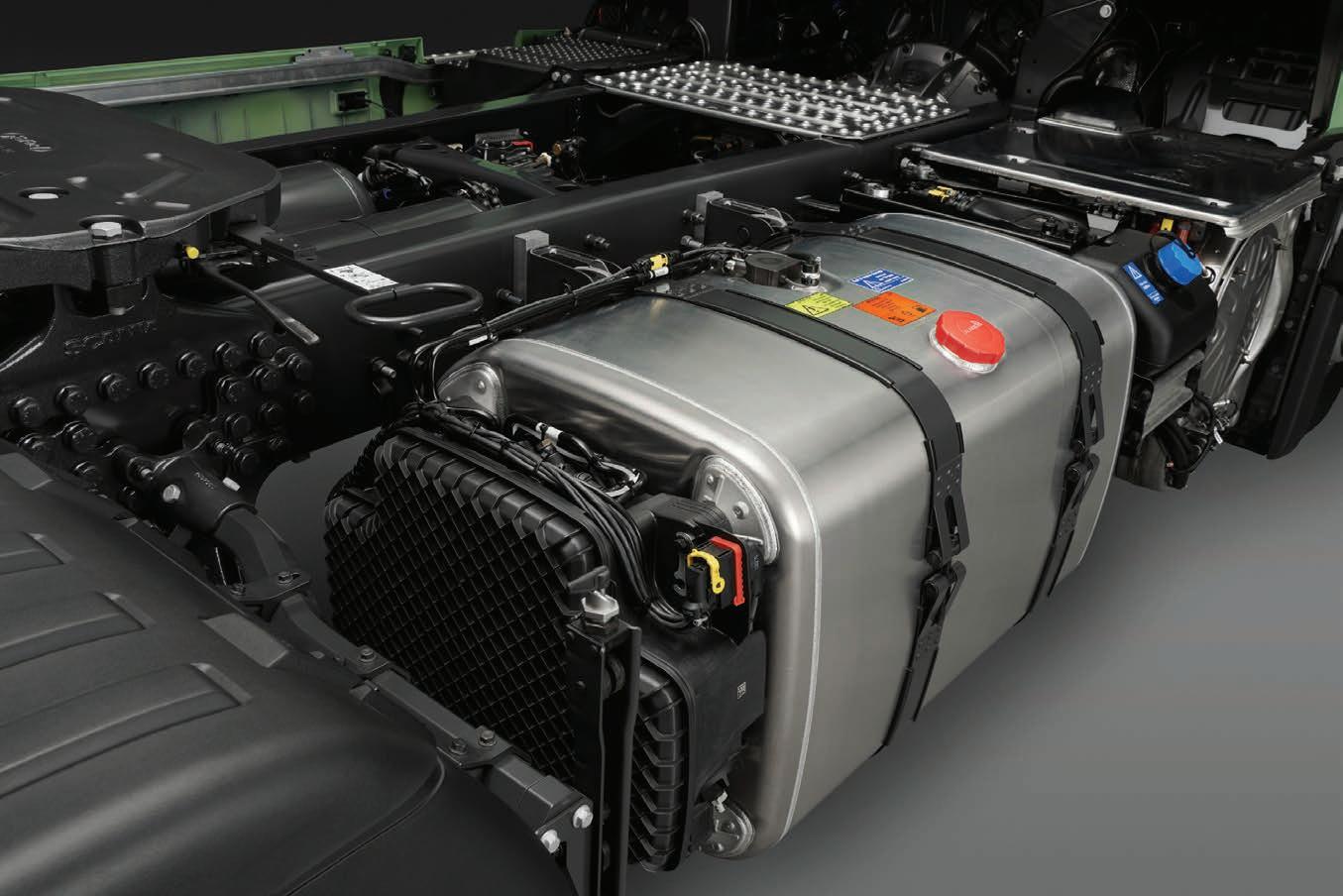
As most truck and engine manufacturers, Scania included, are charging towards the netzero solutions of electrification and/or hydrogen power, Scania has developed what is very likely to be the last internal combustion engine (ICE) to be developed by the Swedish member of the Traton organisation. Five years and two billion Euros have gone into developing the Scania SUPER range that goes beyond its Euro VI engine platform by incorporating new transmissions, new rear axles and even new chassis rails to produce a homogenous combination which delivers a very impressive improvement in fuel efficiency and reduced CO² emissions. The SUPER range also represents the most comprehensive update of the Scania trucks since the introduction of the New Truck Generation into Australia in 2018.

The 13-litre SUPER engine is available in 420-, 460-, 500- and 560 horsepower ratings and is capable of delivering significant fuel savings, especially for long haul applications. Adding to the environmental credentials, the 460- and 500 hp versions can be run on up to B100 biodiesel. All of the new SUPER engines can also run on hydrogenated vegetable oils (HVO).
This new low-rev engine family is available with Scania P-series, G-series and R-series cabs and will be shared across other Traton brands including MAN. In the engine’s development, a broad approach has been taken with fundamental changes such as dual overhead camshafts (DOHC) operating four valves per cylinder and a single piece cylinder head, to detailed reassessments of every other engine component. The engines use ultra-thin long-life oils and auxiliary systems such as alternators and compressors which can be disengaged in order to reduce parasitic power losses.
There has been no carry-over from the earlier six-cylinder engine range to the new
one, with essentially every component being critically examined and revised, from the injectors to the fuel pump. Tweaks to such fundamental components as the crankshaft have contributed to an increase in the engines’ technical life of up to 30 per cent compared to the previous generation, despite extended maintenance intervals. Scania’s Twin-SCR system, which was first introduced to Australia on the new 770 V8 in 2021, injects an initial dose of AdBlue close to the turbo immediately after the exhaust brake butterfly valve, where the exhaust gases are still very hot. The effect is to dramatically increase the total efficiency of the after-treatment system. The second dose of AdBlue is then injected in the usual location inside the after-treatment system. A particulate filter is positioned between the two SCR catalysts and is regenerated without post-injecting extra fuel to the exhaust system.
The new after treatment system is a very compact one-unit solution and offers increased flexibility regarding its position and outlet directions which will be particularly appreciated by bodybuilders looking for space on the chassis. An advantage of the DOHC configuration has been the development of the optional Compression Release Brake (CRB) system. The new engine-integrated brake weighs only seven kilograms and provides a
retardation effect up to 350 kW. The CRB components are all fitted within the cylinder head and involve a separate rocker arm which opens the exhaust valve during the compression stroke and releases the compression just before the piston reaches top dead centre. Hot, compressed air is allowed to escape from the cylinder into the exhaust manifold, building up pressure which spools up the turbo and then exits via the exhaust system. The CRB is activated either via the brake pedal or using the Retarder wand/gear selector or via steering wheel buttons. The design means the conventional exhaust brake and CRB cannot both be used simultaneously. The CRB technology means that many combinations operating in certain locations will not need a gearbox-mounted Retarder, although for high gross weight applications such as interstate B-doubles it is likely many Scania customers will continue to specify the Retarder because of the added safety and reduced maintenance which accompany its maximum brake torque of 4700 Nm.
The SUPER range also comes with a new range of diesel fuel tanks. These have a D-shaped design which improves their robustness. The new Fuel Optimisation Unit is attached to the primary tank and works as a catch tank with electric pumps and ultrasound pressure sensors, enabling
Scania’s all-new 13-litre diesel engine is an important step in the decarbonisation of road transport.Scania 560R B-double.
the truck to have ‘fuel on demand’ with exactly the amount of fuel the engine needs.

Our introduction to the Scania Super series is by way of a back-to-back drive of a 560R B-double grossing 60 tonnes, followed by a 460P single trailer combination grossing around 40 tonnes. The route for each covers a 220-kilometre loop along the Calder Highway north of Melbourne. It includes hill climbing and descending, as well as traffic and road works typical of an Australian inter-city or interstate linehaul operation.


The Scania cabs retain their familiar wellthought-out interiors which focus on driver comfort and extensive support systems. As a major component of the strategy to maximise fuel efficiency, the Opticruise transmissions in both trucks tend to only engage Overdrive when conditions suit. We are told the new transmissions will do more shifting than we might expect, but the new boxes are so smooth and the cab interior so quiet, unless we are watching the indicator readout on the dash, we barely notice many of the shifts at all, particularly while maintaining highway speeds.
Scania introduced the first of its new range of automated transmissions back in 2021 with the overdrive top gear and “tall” diff ratios calculated to keep the engine operating at around the 1,200rpm mark when cruising at 100 km/hr. The
utilisation of faster rear axle gearing encourages running in 12th (direct) gear which provides the lowest transmission losses. The rear axles also feature low friction bearings, lower hypoid offset and improved oil flow with reduced splash losses, all of which contribute to the fuel efficiency, while improved lubrication in combination with more precise machining of the internal components result in extended service intervals.
The G33CM Opticruise transmissions fitted to both prime movers are some 75 kg lighter than before due to all-aluminium housings and smaller overall dimensions. There are 14 forward gears, including a super crawler and the overdrive gear, and up to eight reverse ratios. A pumped oil spray lubrication system contributes to markedly less internal friction and consequential component wear. Internal drag losses are reduced by 50 per cent, while the overall design has lowered the sound levels of the transmission by 3.5 decibels.
The powertrain in the SUPER models is an integrated unit where the engine, the after-treatment system, the gearbox and the driven axles all operate in harmony via sophisticated electronic management systems.
The combination of the new powertrain has enabled Scania to confidently claim an eight per cent fuel saving and early local trails running predominantly on regular
diesel fuel have shown a percentile fuel efficiency improvement well into double digits, even when compared to the efficient engines they are replacing. Scientifically, the thermal efficiency is around 50 per cent for the new engines. Not long ago this would have been unthinkable for internal combustion engines and is close to the efficiencies sought by Formula 1 teams. It’s not all just about the driveline, and introduced in the SUPER range, Scania’s new Modular Architecture Chassis (MACH) provides a new structure for frame hole patterns, with dedicated holes for mounting components both inside and outside the frame. The result is a more modular chassis, which increases the theoretical number of chassis layouts exponentially and increases opportunities for body builders to tailor trucks to best suit operator’s specific applications. The ever-rising cost of diesel fuel and the need to control carbon emissions are two of the main drivers behind the development of the Scania SUPER range. Significant improvements in fuel efficiency can be realistically achieved in many applications with these trucks, which will address those goals with current proven technology. As development progresses on renewable fuels and zero emission vehicles and the infrastructure they require, it’s reassuring that an essentially conventional, albeit very sophisticated, diesel engine is available.
“As someone who works within and around the trucking industry across Australia, I know how important communication is to this huge mobile community.
It is really important to have a voice like Australian Truck Radio – it is just so critical. Anything that can make the trucking industry safer has to be a great thing. Australian Truck Radio is a real winner for the industry.


Trucking is not just a job. It’s a lifestyle that has its own diverse community. It is a great accomplishment establishing Australian Truck Radio to help bring the country together, highlighting important topics for Truckies, including nutrition, which, it goes without saying, is a huge passion of mine.”



Tracey Marley Owner, Truckie Nutrition Chick, Facebook Group



Arecent visitor to our shores as an international attendee at the Brisbane Truck Show, Thomas Hemmerich along with Craig Lee, Penske Australia Onhighway Executive General Manager, spoke to Prime Mover about MAN’s new truck generation range as it settles into the market following its launch in Australia in August 2022.
Prime Mover: You’ve been with MAN for 20 years. Are you a truck, sales or administration guy?
Thomas Hemmerich: Truck and sales. My background is engineering and I love diving into talking with the customers trying to understand what they need. I wouldn’t call myself a finance guy.
PM: The MAN new truck generation range was launched in Europe in 2020 and has been very successful there. Do you think that will translate to success here in Australia?
TH: We won the International Truck of the Year award for new truck generation in 2021, but it’s not about awards. It’s about the feedback we get from our customers. We need to confirm that we deliver on the promises and our promises are uptime, efficiency and, most importantly, driver fit in these times when it is getting more and more difficult to attract truck drivers. The response we are getting is overwhelming.
PM: That must be edifying.
TH: That makes us super proud that we are able to deliver on our promises.
I’m really looking forward to delivering those trucks into the Australian market and to be able to see lots of those trucks on Australian roads and also getting the feedback from the operators as well as the drivers. For the last two years of our development, we have had great support here from the Penske team and I’m very happy to have the Penske commercial team here to sell, support and service our partners.
PM: The MAN new truck generation has some impressive specifications. How well does all that translate into fuel efficiency?
TH: Actually we have recently tested with the current Euro VI technology in Europe and it gives another seven per cent fuel saving. Obviously, we can’t compare a European 4x2 with a 6x4 Australian truck. However, it’s the same driveline, just with a different axle configuration. We’ve gone another major step in the right direction with the European spec being more fuel efficient and the Australian one will also be significantly better than the previous, as well.
PM: What’s the local response been to the new range, particularly from your customers who have trialled it?
Craig Lee: The ‘vibe’ on the previous generation was it was a good reliable truck, and it was adequate to do the jobs asked of it. The feedback from the customers who have tried the new truck is that it is a significantly improved ride and that’s very much around cab sway, and the road noise is noticeably lower.
Those are probably the two biggest pieces of consistent feedback — the comfort of the cab and the quietness in the cab.
PM: Have you received much comment about the drivelines?
CL: The feedback on the 640hp is just how well it holds on from a torque perspective and the engine braking gets a massive rap especially on the Euro VI 510hp and the Euro VI 640hp.
PM: Any feedback on fuel economy?
CL: I think you could confidently say most of the Europeans running around the 13-litre and 500hp mark are all going to be pretty good on fuel, but it’s the drivers that are going to make a big difference. We’ve compared one of our latest generation trucks here and we’ve been playing with axle ratios. We’ve got a dedicated test route with the same driver running the same load and we’ve already seen some really nice fuel numbers from the Euro VI d technology.
PM: A contemporary question: what’s stock availability like?
CL: MAN production have done a very nice job getting on top of sales and have been very kind to prioritise a lot of our volume for Australia. I’m going to use the number of 80 per month landing, month on month, starting this month. That’s a reasonable number as we have 300-odd already sold. We are absolutely aware that the challenge for us is to execute delivery and we’ve now got a good dealer group which we have extensively trained on the aftersales side
of the business, and we’ve also invested in the sales teams. For example, we’ve got another six sales professionals starting in the next four weeks. And we have also invested heavily in parts in the right locations.
PM: Sounds like a major undertaking. CL: One thing that we have been very focused on is ensuring we can support the new truck generation before we put it out there, rather than trying to play catch up. We’ve put a lot of effort in getting our people trained. We expect the new truck generation to not have a

everything right. We’ve recruited another dedicated MAN Technical Trainer who is one of our very best technicians. We sent him overseas to do his training and we’ve now got two dedicated MAN technical trainers training other technicians purely on the new truck generation MAN product.
PM: Is driver training part of the package?
CL: It absolutely is. In ‘MAN speak’ we have what is known as a “ProfiDrive” driver trainer, who is a certified driver trainer based in Brisbane and he is
schedule them for when we do our fuel economy testing involving exercises such as changing differential and transmission ratios.
TH: The secret is how to operate the truck. When I’m driving with our professional driver trainers in Munich the things you can do in order to optimise fuel consumption are amazing. We need to be able to convey this message to the truck drivers and that’s why it is so important to have driver trainers. Eventually it’s about cost of ownership. We are selling a fancy story to the operator and if we are
is imperative.
As a manufacturer, Scania has long realised the importance and potential of driver coaching, particularly in oneon-one situations with a trainer sitting in the passenger seat offering tips to the driver. Peter Clarkson is one such driver trainer. With a 21 year involvement with the Fire Brigade in Victoria, Peter draws upon what were often stressful experiences in operating a fire truck under lights and sirens and exudes a calm demeanour. He makes the initial point of speaking on the drivers’ level and not lecturing them.

“I’m not here to teach you to drive,” is his usual opening statement which sometimes comes as a surprise to his clients. Rather, Peter suggests the drivers see themselves as the conductors of an orchestra. What used to be regarded as the symphonic melding of clutch, throttle and gear-changing has, today, morphed into the operation of the latest electronics-based systems which also involves pre-programming of features such as adaptive cruise and hill descent controls. “My role is to teach them the functionality of the controls of the truck so they can get the best out of it, and they might even save their boss some money by saving fuel,” Peter says. “I’m trying to create new habits with the new technologies.”
Most modern trucks have impressive arrays of switches and control levers, many of which are hardly, if ever, used by typical drivers. An example on Scania vehicles is the load transfer button that Peter
In order to realise the potentials offered by the various electronic-based systems incorporated in sophisticated modern heavy trucks driver trainingPeter Clarkson.
frequently uses as a demonstration, and not just because he can reach it from the passenger seat.
“I ask them if they ever go to Bunnings, and of course, everyone goes to Bunnings,” he begins. “Then I’ll ask: ‘Do you ever buy stuff in Bunnings that you say you’ll use one day?’ That’s like one of those buttons that you just bought from Bunnings. It’s not something you’re going to use every day, but it’s something you’re going to use every now and then.”
Should a driver find themselves on a slippery dock that they can’t get out of, pressing that button transfers the weight onto the ground under the drive axles without putting more weight on the truck.
“When you explain what it does,” says Peter, “I often get ‘I could have used that last week’ as a response.”
As most drivers tend to work alone in their cabs, Peter recognises that for some of them what he does might, at first, appear invasive.
“You can’t get in the truck and say ‘I work for Scania’ and just drill it down their throat,” he says. “You have to speak on their level otherwise the shutters go up.”
Peter’s psychological approach to inclusiveness extends to the apparel he wears. Initially, his uniform was to be slacks and a business shirt, but he saw that as an impediment to his acceptance not only in the cab, but as a credible source of information and advice. Now he wears cargo pants and polo shirts.
Peter is of the view that during the 120 hours of instruction, which some states require for car learners, drivers should spend time as a passenger in a truck to
instill an appreciation of vehicle clearance, vision blind spots, and stopping distances. Such a program would be worthwhile, not just from a safety perspective, but may even lead to the recruitment of new truck drivers. Drivers towing caravans is another area where some time spent in a truck would improve safety. According to Peter there should be a higher level of licencing standards for drivers towing caravans.
“It’s an articulated vehicle,” says Peter. “They’re driving something more than 7.5 metres long with a sign which says, ‘do not overtake turning vehicle,’ so it’s a truck. They buy the littlest car and the biggest caravan and try to tow it up the road and it’s dancing all over the place.”
Peter fine tunes his approach and frequently uses different analogies to illustrate the points he is trying to get across. This often requires him to read his audience.
“I meet different characters from young people who are just starting in the industry, to others who have been driving for 40 years, some of whom have never driven an Automated Manual Transmission such as the Scania Opticruise,” he explains. “I try to break it down into quirky bits such as the world’s strongest man trying to pull a truck and get it moving which is the hardest part, but once it’s moving he’s OK. So try to keep the truck you’re driving, moving.”
Scanias have a driver score system that draws from various metrics to award up to five stars for performance activities such as braking, anticipation, and fuel efficiency. Within some fleets the scoring can be quite competitive between drivers. It can also be

a distraction, so Peter suggests configuring the screen to have the stars in the corner so the driver cab can keep track of it, without compromising the concentration required to operate the vehicle. Part of his aim is to prove the value of the driver score to drivers. Sometimes he will emphasise the importance of nailing the anticipation and braking scores, as those two ultimately go hand-in-hand.
“An intersection or roundabout will always be there — the only thing which may change is traffic and once they start anticipating and coasting more and using the retarder more they hardly use the brake pedal at all,” says Peter. “I suggest anticipation is the five second rule so count five in your head. If, say, a roundabout or slow traffic comes up earlier than five seconds then back off earlier next time.”
Pre-setting functions such as Adaptive Cruise Control and Downhill Cruise brings about good improvements in fuel efficiency as well as safety.
“They’ve got to feel it working to have confidence in it, especially mature drivers,” says Peter. “I tell them if they set it up right, they can drive it all day. Even if they think they are close to retirement, I say they can get another ten years in this Scania.”
Changing mindsets, however, is not often an easy task. Yet Peter relishes his role in assisting improvements in efficiency, safety and driver well-being by providing familiarisation of the controls in the clients’ Scania trucks.
“Every day is different,” he adds. “Every day is a mystery tour.”
Construction of Amazon Australia’s new purpose-built fulfilment centre (FC) in Perth is nearing completion and is set to open this year.
The new FC spans around 20,000 square metres with capacity to house over three million items sold on Amazon.com.au, ranging from smaller to medium items like health, household and personal care products to larger items like TVs and gardening equipment. Located in the Jandakot Airport Commercial Precinct, the new centre is more than double the size of the company’s existing site near Perth Airport which it will replace when it opens. As a result, it is expected to increase Amazon’s operational footprint
in Western Australia by more than 60 per cent.
According to Amazon Australia, it will also increase the storage capacity available to sellers by 500 per cent.
Director of Operations at Amazon Australia, Mindy Espidio-Garcia, said the company is investing in its Perth operations as part of an ongoing commitment to improve selection and delivery outcomes for customers throughout the state.

“Many Prime members in greater Perth will have already enjoyed free next day delivery from Amazon and the opening of this site will increase the selection of items that can be shipped to local
customers quickly,” she said. “Nearly 1,000 construction jobs were created during the build and fit out, and we look forward to welcoming a team of more than 200 people working at the FC once it’s fully up and running.
“People are at the heart of our operations and we are proud to offer a safe and positive work environment and the opportunity for them to build their skills and grow their careers.”
More than 200 jobs will be based at the new FC once fully operational. This includes around 100 new job opportunities in addition to roles filled by existing workers transferring to the new state-of-the-art facility.
Australians are continuing to embrace RAM pick-up trucks, with the American company announcing records sales for last month. RAM Trucks Australia sold 766 pick-ups this past May, beating its previous record of 710 in November last year.
In its segment, market share for the 1500 variant is 65.7 per cent, up from 62.3 per cent over the same period last year.
“This fantastic result is testament to our dealer network and our Melbourne Manufacturing Facility, who have left no
stone unturned in delivering customer orders,” said Jeff Barber, RAM Trucks Australia General Manager. “With the DS Runout Campaign’s very competitive 3.99 per cent finance offer ending this month, coupled with the soon-to-end Temporary Full Expensing tax break, we’re confident that June will see another strong result as we close out the financial year.”
In anticipation of this busy time of year and continued high demand, RAM Trucks Australia has put significant effort into increasing supply and

reducing wait times.
Most dealers, the company said, have RAM 1500 DS and DT models in stock or in transit with the outlook for the remainder of 2023 looking strong.
RAM Trucks Australia is now the biggest vehicle manufacturer in the country with more than 1,000 new parts on the DS, DT and heavy-duty models, providing significant local supply chain benefits.
All RAM Trucks Australia vehicles are international-spec vehicles, uniquely coded for the Australian and New Zealand markets.
Automotive industry body FCAI has announced the appointment of a new Chairperson and two new Board members, following the 2023 Annual General Meeting. Vinesh Bhindi (Managing Director, Mazda Australia) has replaced Matthew Callachor (President and CEO of Toyota Australia) as Chairperson. Callachor has stepped down following three years at the FCAI helm and has been elected Deputy Chairperson, along with Shaun Westcott (President and CEO, Mitsubishi Motors Australia Limited). Carolyn McMahon (Honda Australia) was appointed FCAI Treasurer. John Kett (Chief Operating Officer, Hyundai Motor Company Australia),
Adam Paterson (Managing Director, Nissan Motor Co Australia, Tony Hinton (General Manager, Honda Motorcycle & Power Equipment Australia), Colin Christie (Managing Director, Inchcape Australia), and Stephen Connor (Managing Director, Volvo Car Australia) were returned to the Board of Directors. Thom Drew (Country Manager, Tesla Australia & New Zealand) and Andrew Birkic (President & CEO, Ford Australia & New Zealand) were newly appointed to the Board. FCAI Chief Executive Tony Weber welcomed the Directors and Office Bearers to their positions.
“I would like to offer my warm welcome to our 2023 Directors and
Chairperson.,” he said. The FCAI’s membership encompasses over 63 brands and sub brands. Having a diverse range of Directors on the Board from different areas of the marketplace is critical, according to Weber, for ensuring the FCAI continues to offer the best representation of Australia’s motoring industry.
“With more change occurring across emissions, intelligent transport, business models and customer experience than ever before, I am confident our Board will provide the critical insight and guidance our industry needs as we move forward,” he said.

Major sales increases across most car categories have been reported according to the latest sales figures released by the FCAI. Improved efficiency across the global supply chain helped contribute to strong sales in the Passenger Vehicle Market which increased by 868 vehicle
2,296 vehicle sales (10.7 per cent) and the Heavy Commercial Vehicle Market is up by 595 vehicle sales (14.4 per cent) versus May 2022.
Toyota was market leader in May, followed by Mazda and Hyundai. Toyota led Mazda with a margin of 9,865 vehicle sales and
sold 2371 units.
Toyota sold 18,340 units in May. The HiLux represented 5772 of them. having improved its sales by 11.5 per cent compared to the same period last year. Ford sold 6,251 units, the majority of which were the Ford Ranger (4110). Mercedes-Benz was the best performer in the van category with 240 sales, for a total
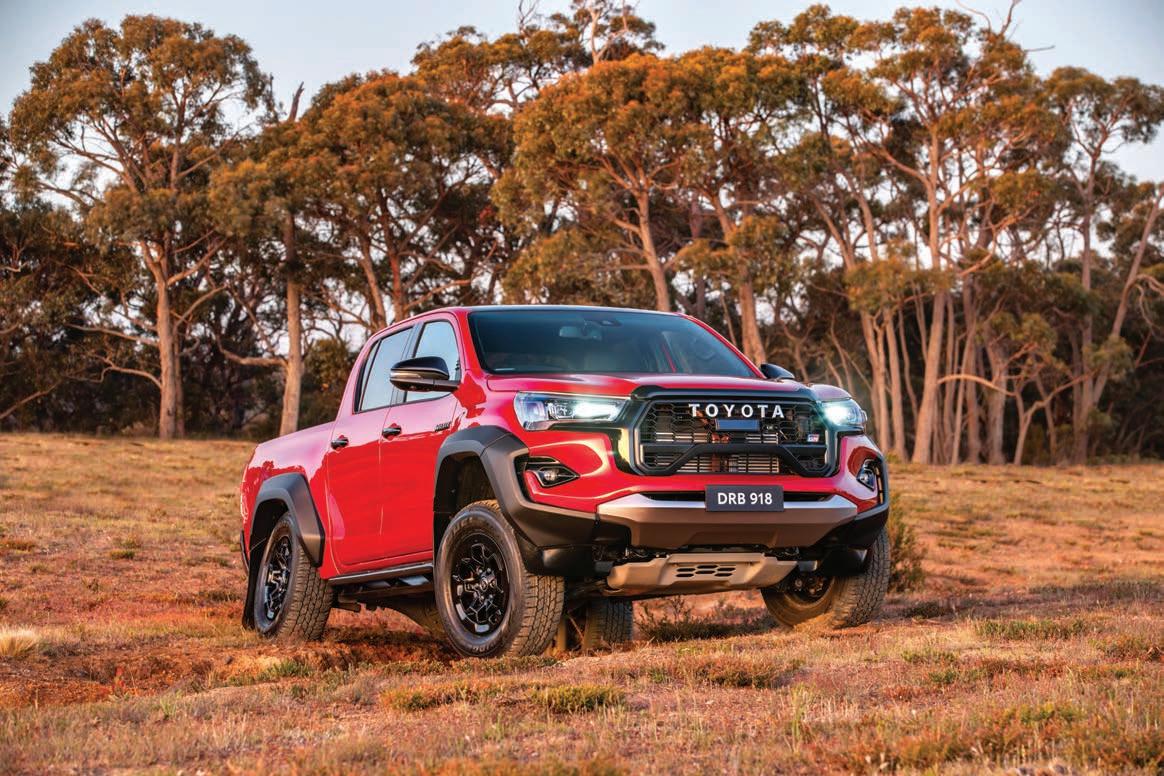


Roadside inspections not only identify unsafe carriers but can have ramifications up and down the supply chain, impacting senior management, insurance premiums, customers and reputations. It’s critically important to have a contingency plan in place on how to handle damage-related downtime. Every day a truck is not on the road it costs a business money. For fleet management to improve its culture of safety it must have a dependable repairer and be able to centralise its maintenance and safety management for its insurers. More than ever it’s vital to have complete records of driver coaching, maintenance both performed and scheduled, and claims made to expedite insurance renewals. It’s no coincidence a strong workshop culture incorporating practical and theoretical heavy vehicle safety and management is increasingly being associated with best practice risk-management. If your business is contributing to safety culture through insurance, repairs or workshops our September edition is the platform for you.
The Ford E-Transit fully electric van is now available from authorised dealers throughout Australia. Power is driven through the independent coil sprung rear axle from a 195kW electric motor with the impressive torque characteristics of 430Nm compared with the standard diesel Transit’s 125kW/390Nm specs. Electricity is stored in a 68-kWh lithium-ion battery pack located under the floor of the cargo area.
The charging socket is located in the front grille and a Mode 3, 32 amp charging cable is included as standard equipment. Overnight AC charging using the on-board 11kW charger takes around eight hours to achieve full charge capacity. An 115kW maximum DC charger is also available which can take the battery capacity from 15 per cent to 80 per cent in just 34 minutes. Driving range for the mid-roof version is 230-307 kilometres based on the Worldwide Harmonised Light Vehicle Test Procedure (WLTP), which is an acronym we’ll be seeing more of over the coming decades. Using the same standard, the range for the high-roof E-Transit is 222-295 kilometres.
The E-Transit has three drive modes which can be selected using the 12-inch touchscreen or via the “transmission” dial located on the centre console. Eco mode is programmed to maximise driving range by limiting maximum speed and by regulating acceleration and
the power drain of the climate control system. To minimise battery drain and maximise power and range, the E-Transit can be programmed to set a desired cabin temperature prior to being disconnected from its charger. The default Normal mode is best for everyday driving and Slippery mode improves the E-Transit’s traction in low grip road conditions.
The compact design of the semitrailing arm rear suspension is similar to what will be found in the Ford Mustang EV when it arrives and allows for an 11 cubic metre load capacity in the mid-roof versions, and 12.4 cubic metres in the high-roof models which correlates with the equivalent dieselpowered Transits. The GVM of 4.25 tonnes allows a payload of 1,611 kgs in the mid-roof and, due to its slightly higher tare weight, the high-roof can handle 1,566 kgs of load. The location of the battery pack also provides the E-Transit with a low centre of gravity which in combination with the rear wheel drive and coil sprung rear suspension provides good traction and stability regardless of the load being carried.
The E-Transit’s battery pack has liquid cooling to ensure optimum performance in extreme weather conditions. Rigorous testing to prove the durability of the battery pack, electric motor and rear axle involved situations such as repeatedly driving through mud and salt baths and through salt water sprays. The
electric motor’s reliability was tested by operating it continuously for 125 consecutive days.
In common with the entire current Transit range, the E-Transit features Ford’s SYNC 4 system which has enhanced voice control as well as an intuitive 12-inch wipe clean, glare resistant touchscreen.
Wireless smartphone integration means access to Apple Carplay and Android Auto without the need for a USB cable. The connected satellite navigation delivers live updates on traffic and parking as well as available battery charging stations and even weather updates. The SYNC 4 system has the capability to suggest route changes in order to access recharging facilities according to the state of charge of the battery. It can even take any necessary re-charging times into account when estimating the time of arrival at the selected destination. The driver’s seat is electrically adjustable and the steering, with its multiple controls, is adjustable for angle and reach. Front and side airbags are standard as are rain sensing wipers and automatic headlights, climate control and a DAB+ digital radio.
The E-Transit incorporates the same active safety and driver assistance systems available on the entire Transit range including Autonomous Emergency Braking (AEB) with Pedestrian Detection, Adaptive Cruise Control, Blind Spot Monitoring and Assist, and Lane Keeping Aid with Lane
Departure Warning. A rear camera and parking sensors are also standard equipment.
A typical advantage of electric vehicles is regenerative braking which harvests energy that would otherwise be lost when coasting or braking lightly. The recovered energy is stored in the battery to contribute to the vehicle’s driving range. In the E-Transit the accelerator lift-off regeneration is always active and can be further optimised in “L” mode via the rotary dial drive mode selector to significantly increase the regenerative braking effect and also raise the charging rate for the battery.
Access to the cargo space is via a standard sliding door on the kerbside and glazed barn doors at the rear which fold to 270 degrees. A sliding door for load area access from the driver’s side is an option which costs an additional $1,000.

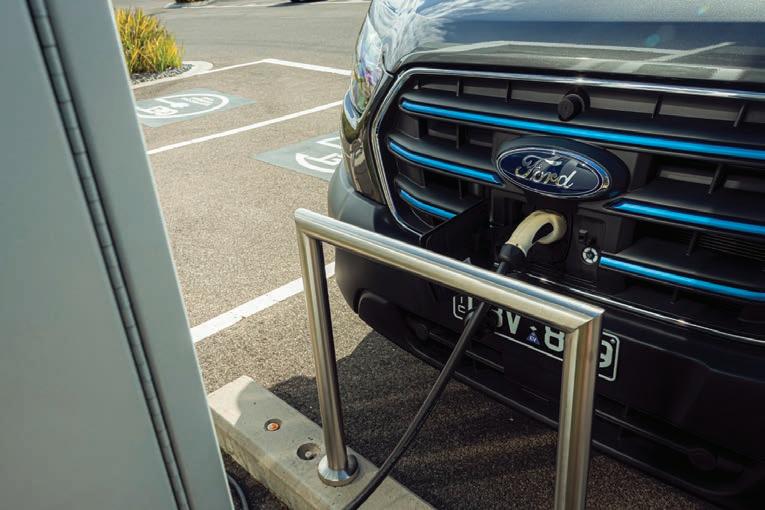
The cargo area has a plastic floor liner and insulated internal liners on the walls and there are ten tie-down points to secure cargo items. A steel bulkhead with a window separates the cargo and driver’s sections. Interestingly, the E-Transit does not have a trailer towing rating, a situation which appears to be in line with most other Light Duty battery electric commercial vehicles.
The E-Transit is covered by Ford’s fiveyear, unlimited kilometre warranty with an eight-year or 160,000-kilometre (whichever occurs first) warranty package for the battery and highvoltage electric components. Service intervals for the E-Transit are 12 months or 30,000 kilometres, whichever comes first, and contributes to the EV’s lower total costs of ownership and operation.
Initial Australian pricing is $104,990 plus on-road costs for the mid-roof and $106,490 plus on-road costs for the high roof version. The E-Transit forms a part of Ford Australia’s electrification plans with an intention to bring at least five electrified vehicles to this country by the end of 2024.

Ride-sharing giant Uber has announced it’s gone green, and it celebrated with a global launch in London recently. It’s all part of the company’s environmental commitment to become a fully zero-emissions platform by 2040. In Australia, where a similar launch took place, the company reiterated that it would now be offering more sustainable options for consumers, drivers and restaurants.
The main initiative, which is now live and available on the Uber app, is a choice between a standard UberX vehicle, or a hybrid or fully electric vehicle, at no extra cost. It’s now available to users in Sydney, Melbourne, Brisbane, the Gold Coast, Perth, Adelaide and Canberra.
“Australia’s path to net-zero is going to take a concerted effort from all of us, and Uber is stepping up to play our part,” Uber ANZ General Manager, Dom Taylor says, adding that, according to studies, light vehicles in Australia account for about 11 per cent of its greenhouse gas emissions.
“We have a responsibility to offer more sustainable choices across our platform and to do our bit in accelerating Australia’s path to zero emissions,” he says.
The government appears to be throwing its full support behind the initiative with Queensland’s Minister
for Transport and Main Roads, Mark Bailey, taking the very first Uber Green trip and giving the innovation his unreserved endorsement.
“As we transition to net zero, we need to bring industry along the journey with us, particularly in emissions-heavy sectors like transport,” he said. “It’s through these simple changes in our day-to-day routines that we will reduce our emissions and achieve our net zero target.”
The emissions conundrum in the last mile of delivery is certainly real. It arguably produces more pollutants per package than any other segment — delivery trucks driving considerable distances often to delivery only one package. According to a report by global network, Clean Mobility Collective, the average delivery truck travels approximately 25 kilometres per delivery and spends an average of 25 per cent of its time idling, emitting 90 kilograms of CO2 per day. While not exclusively considered a last mile delivery service, Uber does hold onto a piece of the last mile pie with its Uber Eats and Uber Direct offerings, and certainly other transport and logistics companies will be watching its green movement unfold with curiosity.
Uber appears to have had forethought when it comes to administering this new initiative, having taken on board
consistent feedback from drivers that the lack of affordable electronic vehicles and chargers in Australia is a significant barrier in making the switch. Last year, Uber Australia announced $26 million in incentives to help encourage more drivers to consider going electric. Uber Green’s offering includes an emissions savings feature

A new initiative from Uber has made international headlines as it sets its sights on a zero-emission future. To some, it might appear like an inflated marketing campaign, but last mile delivery providers should take note with research showing green equals profitability.QLD Minister Mark Bailey during his Uber Green trip.
on the app, which shows how much emissions users have avoided each time they choose an electric uber ride or delivery; access to dedicated pick-up zones in preferred locations at airports; a new Uber Carshare product, which facilitates borrowing a vehicle; and smart-charging info in real-time for drivers, which will include price, waiting times and traffic.
Uber and bp pulse have introduced exclusive incentives and EV charging discounts to drivers across Australia and are hopeful that by the end of the year, Uber drivers will be able to save between 5-8c/kWh on the cost of charging at any bp pulse charging station.

“We’re bringing the best of our global expertise in EV charging to build Australia’s most convenient EV charging network,” said Frédéric Baudry, President, bp Australia and SVP fuels & Low Carbon Solutions, Asia Pacific.
“Our customers’ mobility and convenience needs are changing, and, as we have been over the last 100
years in Australia, we’re on the journey with them.”
While ultimately, going green is viewed as the right thing to do for the planet, it could give Uber a leg up in market as well. A 2022 study by B2B customer research agency Sapio found that 54 per cent of consumers would accept longer lead times when dealing with a company that placed a higher importance on sustainable delivery. In addition, 20 per cent said they would pay more for a delivery from an environmentally friendly company. Aside from brand reputation, there is the argument that going green can improve profitability and reduce costs.
A study by international non-profit, CDP, found that companies that actively plan with climate change in mind secure an 18 per cent higher return on investment than companies that do not. The study, which was conducted on a sample of 5,000 companies, found that those that were actively managing and planning for climate change were more likely to see increases in revenue, profit,
and shareholder value. The reasons for this are mixed, but generally, the belief is that these companies are able to identify and mitigate risks associated with climate change, such as supply chain disruptions or regulatory changes, and are also more likely to develop new products and services that meet the needs of a changing market.
Unsurprisingly, the study found that it’s the transportation sectors that are particularly vulnerable to the impacts of climate change, and they are also the ones that have the most to gain from developing new technologies and practices that can help to reduce emissions.
A newly updated algorithm for drivers that takes fuel consumption into consideration and plots routes accordingly is also part of Uber Green. The company confirmed that a plan is in place to make all Uber Eats deliveries emission free globally by 2040 and remove all unnecessary plastic waste from deliveries by 2030.
In my June Prime Mover magazine article, I described how Australian trailer braking systems on new trailers can be certified by calculations. ARTSA-i has developed a brake calculator that can be used for trailer certification. It can also be used to predict general heavy vehicle brake system performance which is useful to certify brake modifications, and Performance-Based System (PBS) vehicle performance. ARTSA-i has developed the calculator with support from the Heavy Vehicle Safety Initiative (HVSI), which is a federally funded grants program

administered by the NHVR on behalf of the Australian Government. The calculator will predict the deceleration performance of any of the vehicle types shown in Figure 1 when they are loaded and unloaded. The calculator is applicable to heavy vehicles with full air brakes. The ARTSA-i calculator has a ‘wheel-lock’ model that predicts the brake level at which wheel lock-up will occur. All brake calculators should have such a feature; however, to my knowledge the only one that has is the ARTSA-i brake calculator. When locked up, a wheel is unable to provide road-handling (lateral) forces during heavy braking. The result can be side-sliding and loss of directional control. The new trailer design rule ADR 38/0* requires (at Clause 11) that the wheel on a trailer not exhibit wheel lock-up until a deceleration performance level of 0.45g is achieved.
Well balanced brake systems will not exhibit wheel-lock until emergency brake levels occur. Whilst some might argue that an ‘Antilock’ feature, which is standard in an ‘EBS’, will protect against wheel lock-up, the operation of Antilock on a heavy vehicle is
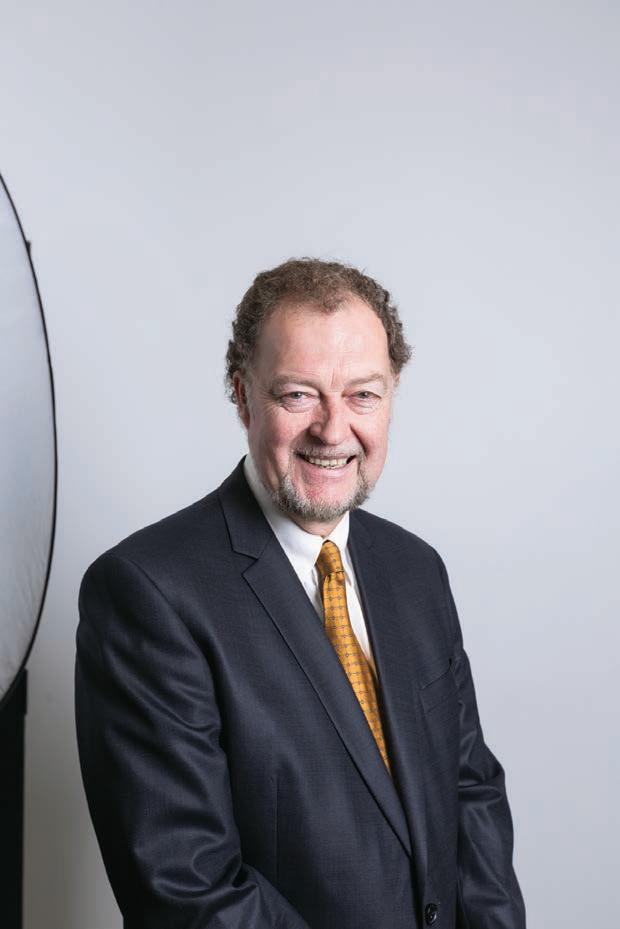
undesirable because it lessens stopping distance performance. A brake system should always be designed for maximum unaided performance. The brake designer or modifier can use the ARTSA-i brake calculator to optimise or verify the brake performance.
The wheel lock-up model in the ARTSA-i brake calculator is illustrated in Box 2. If the utilisation of any axle on the vehicle exceeds the available road friction (which is usually set at 0.75 but can be adjusted lower for slippery surfaces), then the retardation force is set to a fixed level (that does not increase as control level is increased). The other aspect of the wheel lock-up model is the transfer of weight during deceleration from the rear axle group to the front axle group, and transfer of weight within the axle group. This allows the calculator to predict the lock-up of wheels on each axle, which is needed to determine compliance with brake rules by calculation rather than test. The ARTSA-i brake calculator calculates weight transfers during deceleration braking.
Some main outputs of the brake calculator are illustrated in Box 1.
They are the stopping distance and the deceleration of the vehicle as a function of the foot pedal brake control level (0 –650kPa).
The brake calculator has been developed so that brake engineers and vehicle modifiers can predict the performance of a brake system without testing.

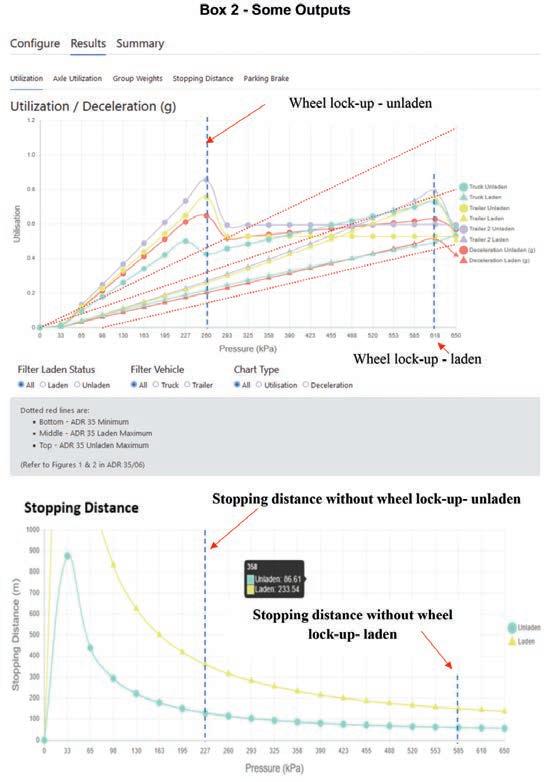

This is especially necessary for trailer certification and for checking that a modified heavy vehicle complies with rules.

The calculator is user friendly and allows a very complex vehicle to be specified in a few tens of seconds. Some of the set-up pages are shown in Figures 2 & 3. The calculator contains a library of the brake Component Type Approvals (CTAs) for foundation brakes. The user can select a particular brake make and model and the calculator will populate the parameters. Readers with an interest in using the brake calculator should email ARTSA-i at exec@artsa.com.au. The ARTSA-i brake calculator is intended to be a freely available tool for industry and it is another demonstration of the benefits that are flowing the Australian Government’s Heavy Vehicle Safety Initiative program.
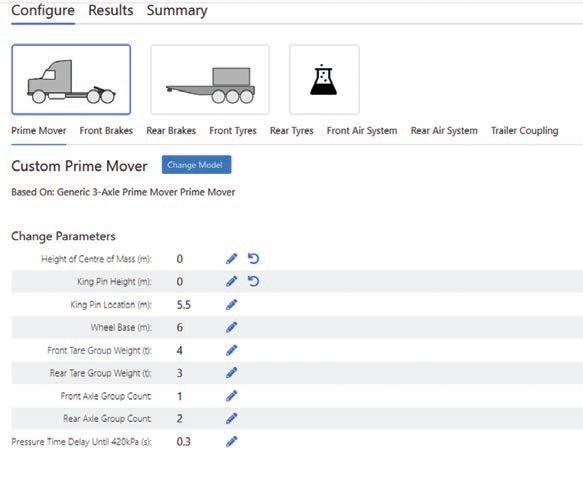 Dr Peter Hart, ARTSA-i Life Member
Dr Peter Hart, ARTSA-i Life Member
Over the last four months I have written in this column about the ‘Issue of our times - Climate Change’. The decarbonisation of road freight is very much on the minds of truck manufacturers as they bring to market new zero emission product and continue to research and develop the advanced technologies needed as a response to increasing CO2 levels.
I have painted a realistic industry position that acknowledges the tenor and expectations of the political and community discourse within which the Truck Industry Council advocates. In so doing I have spoken of the need for “reality to meet ambition”. Australian Governments, Federal and State, have set their economy wide targets. The Federal Government has set the ambition of 43 per cent reduction in CO2 emissions below the 2005 levels by 2030. The reality lies in what new technologies truck manufacturers and importers can bring to the market today and in the near-term to 2030 and the appetite for operators to embrace these vehicles. The technologies beyond 2030 are still being developed. I further spoke of how the road freight sector is recognised by Government as a hard-to-abate sector. This being the case because of varied types and applications for trucks in our communities. Each truck and its use are different, spanning sectors from urban delivery to remote area
roadtrains. Add to this the challenges the industry currently faces with regulation in Australia, such as vehicle width and axle mass limits not suited to the adoption of zero emission vehicles and the need to provide truck purchasers with certainty through a reworked Road User Charging mechanism where operators are incentivised, not penalised, for purchasing low and zero emission vehicles. Finally, I posed the need for a transition plan that promotes the objective of setting a realistic strategy to achieving carbon reductions in the sector. Readers were left to contemplate the statement, in this hard-to-abate sector, “What’s better, near zero, or nowhere near zero?”
With this context in mind, I turn to the detail of the Truck Industry Council’s transition plan being advocated to Government. On current trends
Australian road freight transport will achieve a 2 per cent CO2 reduction by 2030 well short of the Government’s 43 per cent target by 2030. But is such a target feasible for the sector? In a word the answer is No! TIC is not alone in believing this. Europe’s transport target is 12 per cent by 2030. Can Australia get to 12 per cent? In a word, the answer is yes. Here’s how.
The starting point is for Australian Governments to acknowledge that in the road freight sector there is a need for a transition plan. The switch to carbon neutrality will not be a light switch moment.
TIC’s 2030 National Low and Zero Emission Transition Plan is built upon five-pillars.
Pillar One: Technology neutrality; Government’s should not pick winners. OEMs are working on a suite of zero emission technologies to address carbon
neutrality. The current emphasis is electric trucks; by 2030 electric trucks alone will achieve a 2 per cent saving.
Pillar Two: The inclusion of Low Emission Trucks, principally, hybrid electric trucks; by 2030 this measure can achieve a 1 per cent saving.
Pillar Three: Target CO2 emission reduction from the entire Australian fleet. Potentially 98 per cent of the truck fleet will still be using diesel in 2030. The fastest approach to reducing emissions within the sector is to empower the existing fleet by using renewable fuels (R5, or R10), by 2030 this measure can achieve a 5, or 10, per cent saving.
Pillar Four: Modernising the Australian Truck Fleet. TIC has long advocated for the renewal of Australia’s very old truck fleet. Given TIC’s lead, Euro VI trucks are part of the solution because they use less fuel. By 2030 this measure will achieve a 2 per cent saving. Pillar Five: Moving more with Less. By increasing network access for High Productivity Vehicles, this measure could achieve a 2 per cent saving before 2030.
Collectively, industry wide savings of between 12 and 17 per cent.
At the core of this issue of climate change and the actions necessary to abate carbon is an economy wide restructure the likes of which have not been seen before. We have seen examples of industry specific restructuring for example, in forestry, dairy and fishing. In this hard to abate sector, to achieve significant carbon reduction, TIC is calling for a structural adjustment package to transition operators from the current undesired state to the low carbon desired state.
Tony McMullan CEO, Truck Industry Council
It’s hard to believe as this issue goes to print that we’re half-way through the calendar year. Much has happened in these first six months of 2023, providing context within which to reflect on our achievements, and consolidate our focus on the tasks and objectives that remain.
Training remains at the fore for the VTA, primarily out of necessity to professionally train drivers the industry is so desperate for, and to enshrine higher levels of professionalism throughout the freight industry and the supply chains we service.
We’re on our way to achieving our goal this year of training at least 1000 people in freight and logistics roles, from heavy vehicle and forklift driving through to warehousing and distribution centre roles.
Through the support of the Victorian Government, which recognises the value in providing training to produce higherskilled, competent, and safer freight workers, we’ve trained hundreds of new and existing transport workers through our Driver Delivery and Freight Industry Training programs.
Freight Industry Training, in partnership with the Victorian Government, is addressing the significant unmet workforce demand that our industry is currently experiencing. The project offers approved training in heavy vehicle driving, forklift driving and warehouse skills, followed by referrals into positions

with leading transport and logistics companies.
What’s so encouraging about the program is the interest it has attracted from women and indigenous Australians, one of the key objectives of the program. We know that women actively pursue new career opportunities, especially after prolonged time away from the workforce raising children, which is why this program was deliberately calibrated towards women and women over 45.
Our Driver Delivery program is also continuing to attract and train new heavy vehicle drivers, whilst also assisting our advocacy for driver licencing reform that is based on timebased professional instruction instead of just experience behind the wheel. The program has seen hundreds of drivers enter the industry in partnership with the VTA, which then actively mentors them in their new roles.
More recently, and in conjunction with Engistics and the National Heavy Vehicle Regulator, the VTA has been offering a series of free Oversize Over Mass Load Restraint Training Programs for operators throughout regional Victoria and Melbourne. Safety takes many forms and as important as it is to drive safely, it’s equally important that loads are correctly restrained in the interests of overall road safety.
The series has proven popular with the initial workshops in Melbourne, Portland, Geelong, and Sale extremely well-attended. Further workshops are being held through until August so contact the VTA on 03 9646 8590 if you’re interested in attending.
Recognising freight workers for their safety accomplishments is almost as important as producing and training safe workers, so it was with considerable delight that the VTA has been able to
resume our Driver Salute recognition program which, like so many things, was interrupted by the pandemic.
Driver Salute is a bi-monthly reward program held in conjunction with Goodyear Dunlop and DriveRisk for heavy vehicle drivers who demonstrate outstanding and consistent safety practices behind the wheel. The community rightly has an expectation that heavy vehicle drivers will prioritise the safety of the motoring public and themselves ahead of everything else. Driver Salute recognises these drivers and demonstrates to the public the transport industry’s commitment to enshrining a best practice safety culture in every heavy vehicle driver.
We were very pleased to recognise three outstanding drivers in the first half of 2023. Drivers Luke Traintafillou from Vulcan Steel, Tony Waalwyk from Bingo Industries, and Ross Maw from AKD Colac, were selected as winners for their demonstrated knowledge of safe driving behaviours and an ability to put them into practice while out on the road. Looking ahead, heavy vehicle reform and advocacy to help reduce cost pressures in the supply chain will remain a focus for the remainder of the year. The federal parliament will soon review draft legislation around minimum standards, which the VTA through ARTIO, and together with other state-based industry groups, are advocating for in relation to operation, cost, and people management within the road transport industry. I look forward to continuing to work in close partnership with operators and drivers in achieving our vison of improving the environment upon which our great industry operates.
Peter Anderson CEO, VTA
The much-anticipated Brisbane Truck Show was held over four days mid-May and certainly didn’t disappoint organisers, exhibitors or the 42,855 attendees, with a total of 23 brands from 16 OEMs on display, many featuring new models and new technologies. The overall attendance was a record and 15 per cent higher than any previous show and the Thursday, traditionally regarded as a “trade” day with most attendees being from the industry, was up 37 per cent on the previous record for the day. The distraction of the show didn’t have much effect on the delivery of new trucks during the month of May with the Truck Industry Council reporting 3,760 new trucks being delivered, an increase of 14.5 per cent over May 2022’s result.
The year-to-date accrual of 16,076 trucks shows a consistent 14.4 per cent increase over the first five months of last year.
The Heavy Van category recorded 510 new units during May, which may only be 17 units more than for the same period last year, but contributed to maintaining the year-to-date rate of increase at 22.6 per cent with 2,265 units in total for the first five months of 2023.
The Heavy Duty truck category recorded 1,531 new units during May, 257 more than in May last year (+20.2 per cent), taking the year-to-date total to 6,441, which represents growth of 1,119 units over five months (+21 per cent). The stampede to capitalise upon the benefits of the instant asset tax write off scheme which ends 30 June has been tempered only slightly by the shortage of vehicles and components. Most OEMs are reporting strong forward orders well into 2025 even without the tax incentive. As expected, the Medium Duty category was not as frantic as Heavy Duty in terms of deliveries during May and the 684 units sold shows a modest growth of 6.0 per cent (+39 units) compared to May 2022. The year-to-date result of 2,891 trucks was almost line ball with the same period last year (+ 10 units, a growth of 0.4 per cent).

Light Duty results were also strong with 1,545 units, up 180 over the same month in 2022 (+13.2 per cent). The YTD accrual of 6,744 units shows an extra 895 light trucks (+15.3 per cent). The overall sales for the month of May of 3,760 units across all three truck categories is the highest since June 2022. Future
growth, particularly in the Light Duty division, can be expected to come from the increasing availability and adoption of electric vehicles. As an example, grocery giant Woolworths has announced the target date of 2030 to completely phase out its 1,200-strong fleet of internal combustion grocery delivery trucks. Following a trial of two battery electric delivery trucks over the past two years, the first 27 electric vehicles will begin operating in Sydney over the coming months. Other retailers such as IKEA are also committed to new battery electric trucks.

Behind everything you do, are transport workers - delivering our food, fuel and online shopping, as well as taking us to school, work and on holidays.
And behind them is TWUSUPER, the industry super fund for the people who keep the country running.



Shell Rimula ULTRA works harder to reduce your costs, with up to 2% increase in fuel economy*, so you stay on the road for longer.

Heavy Duty Diesel Engine Oil
